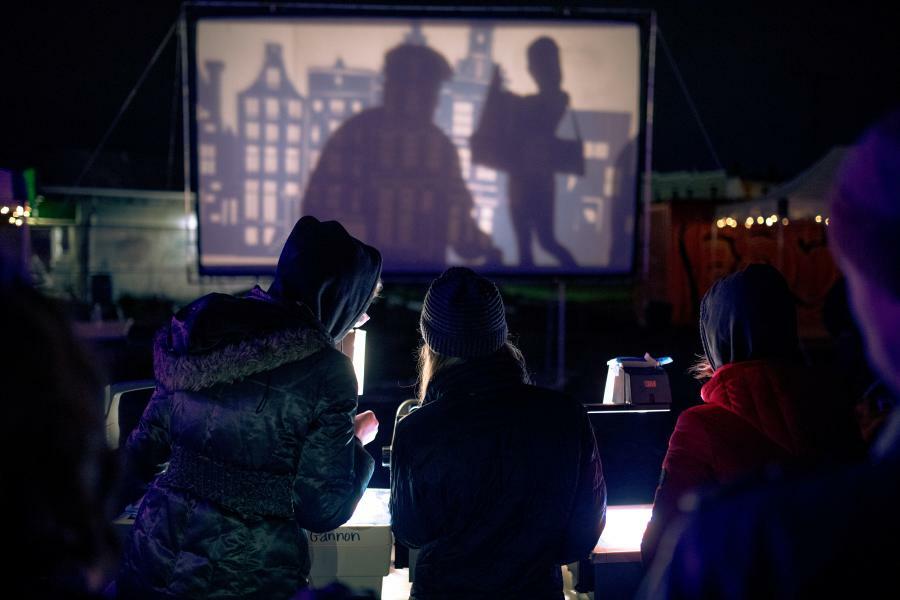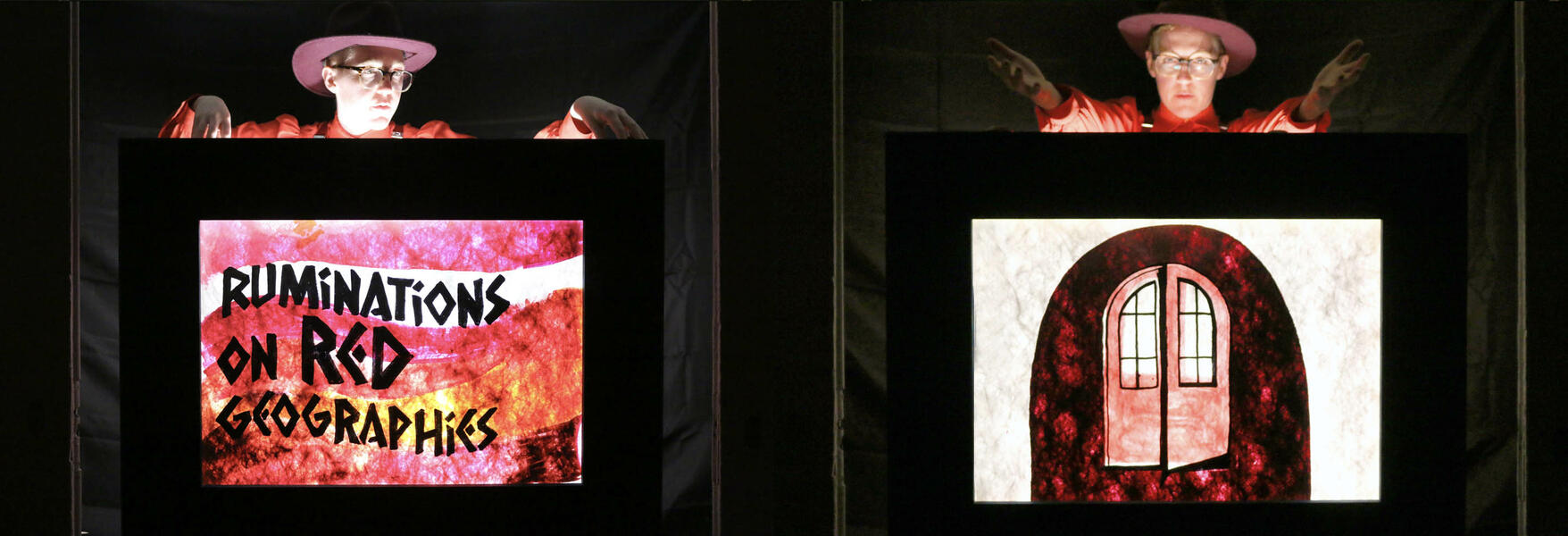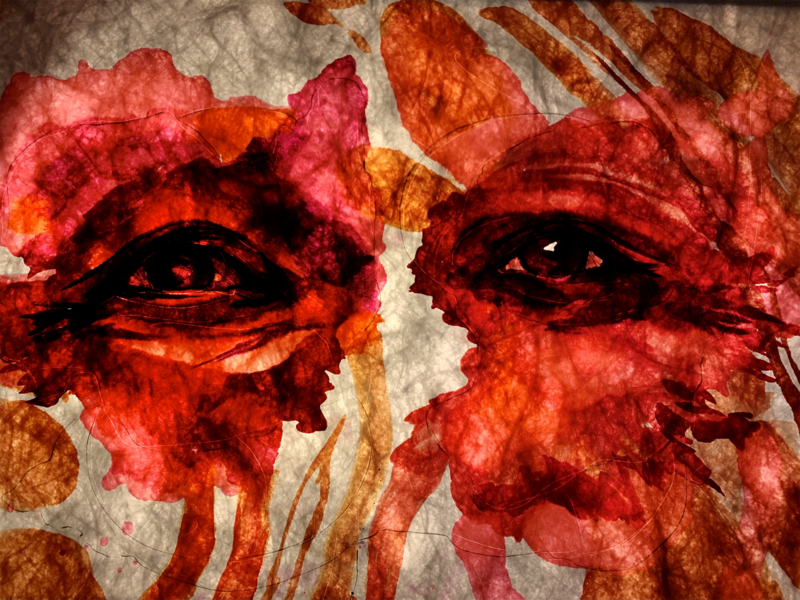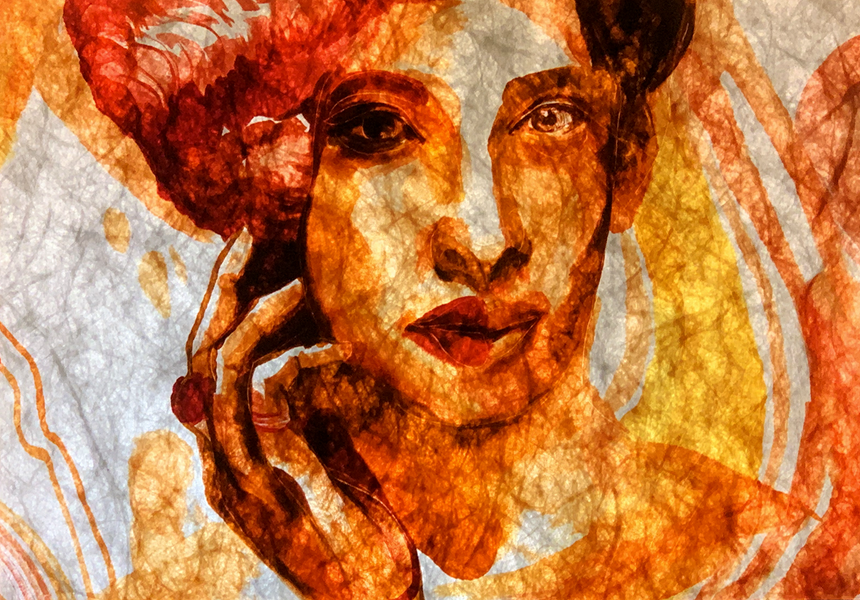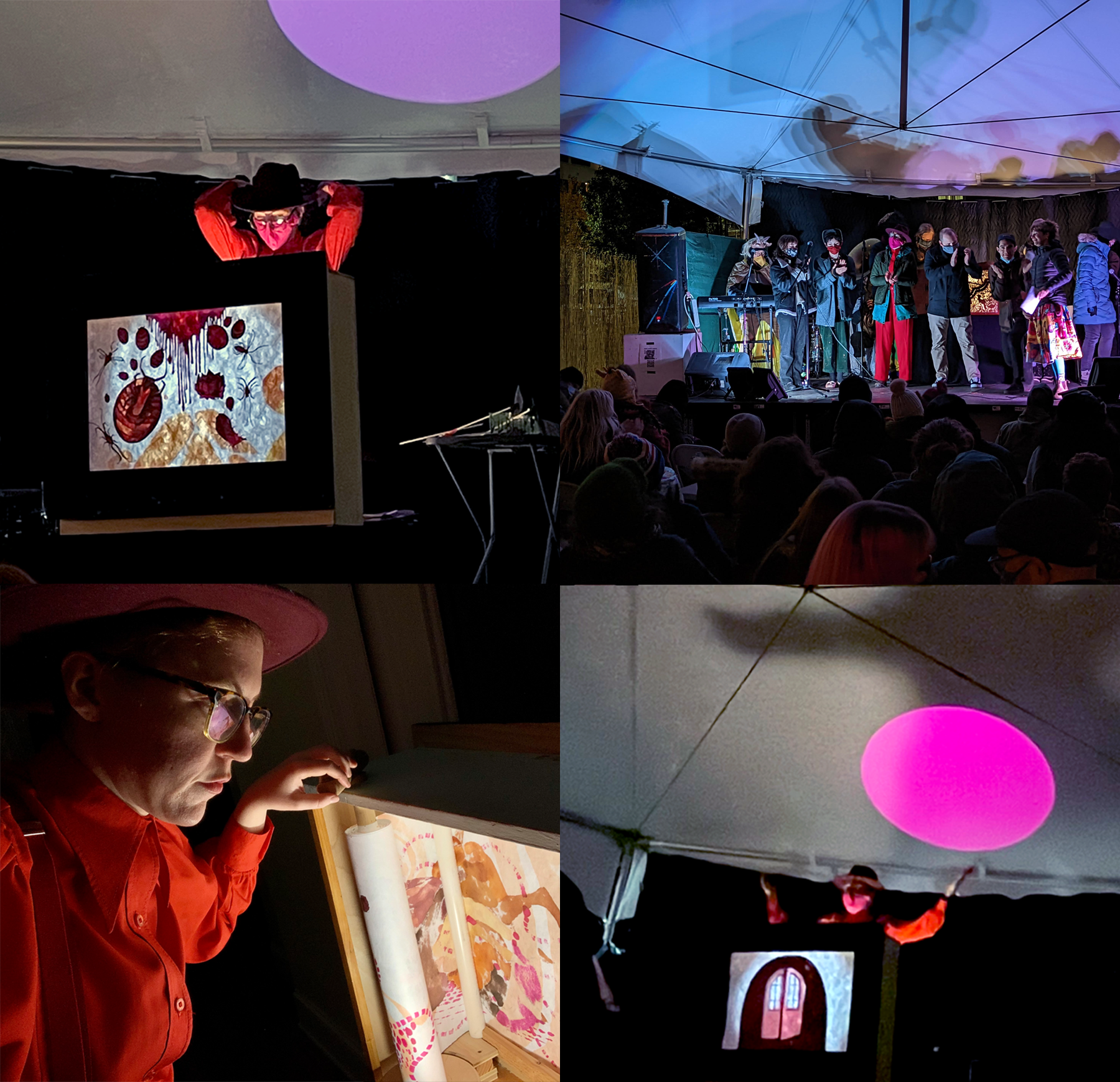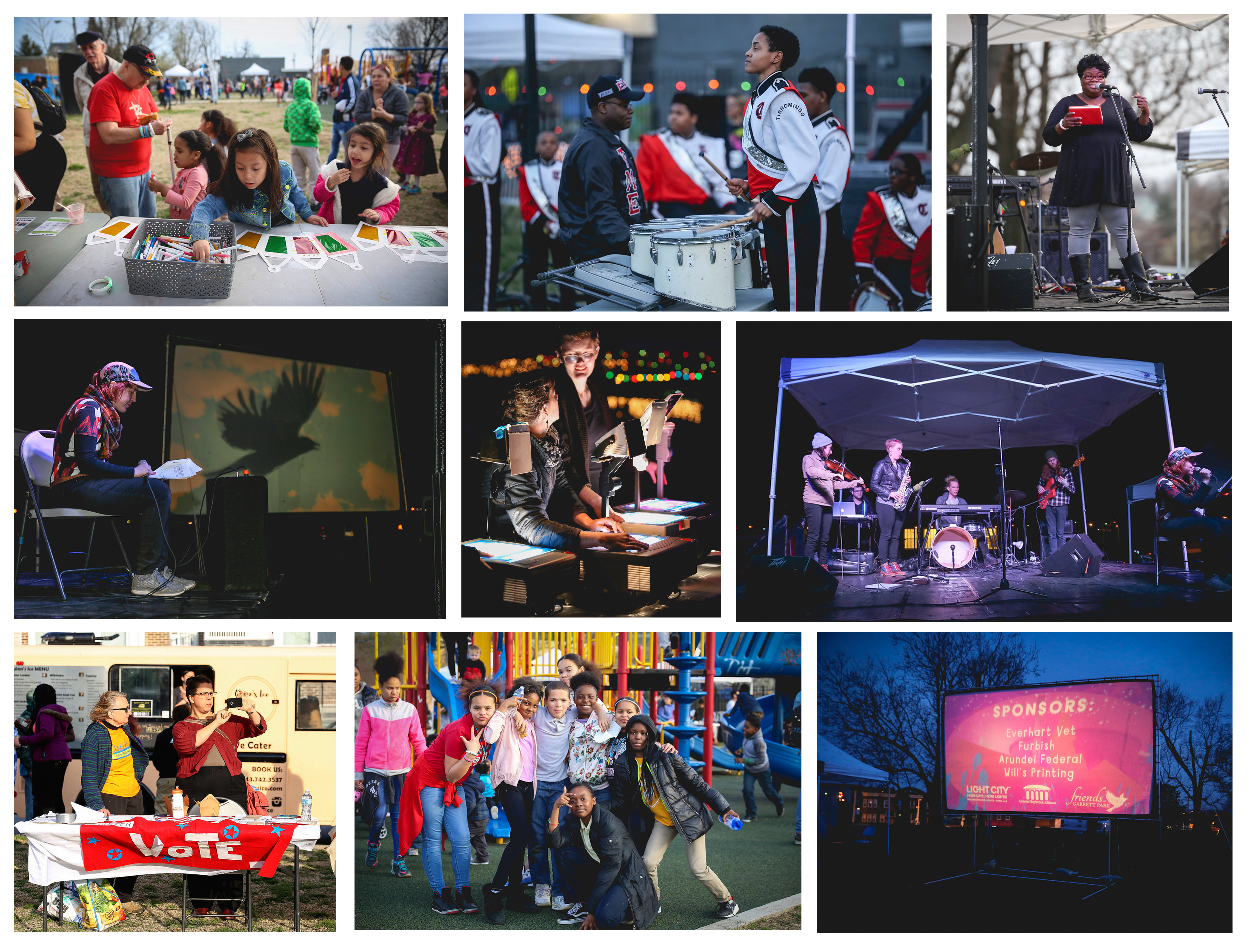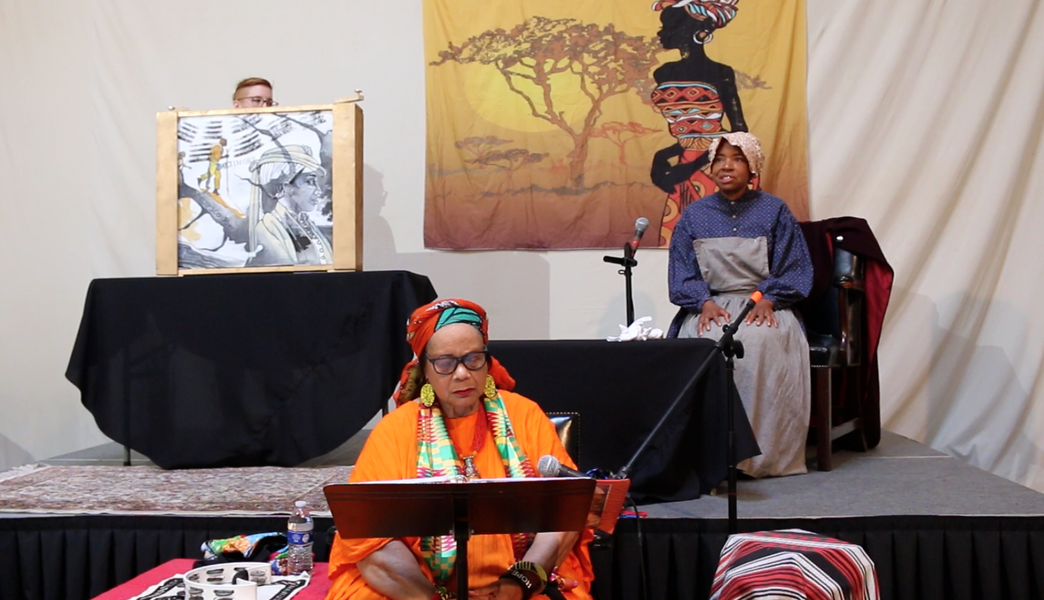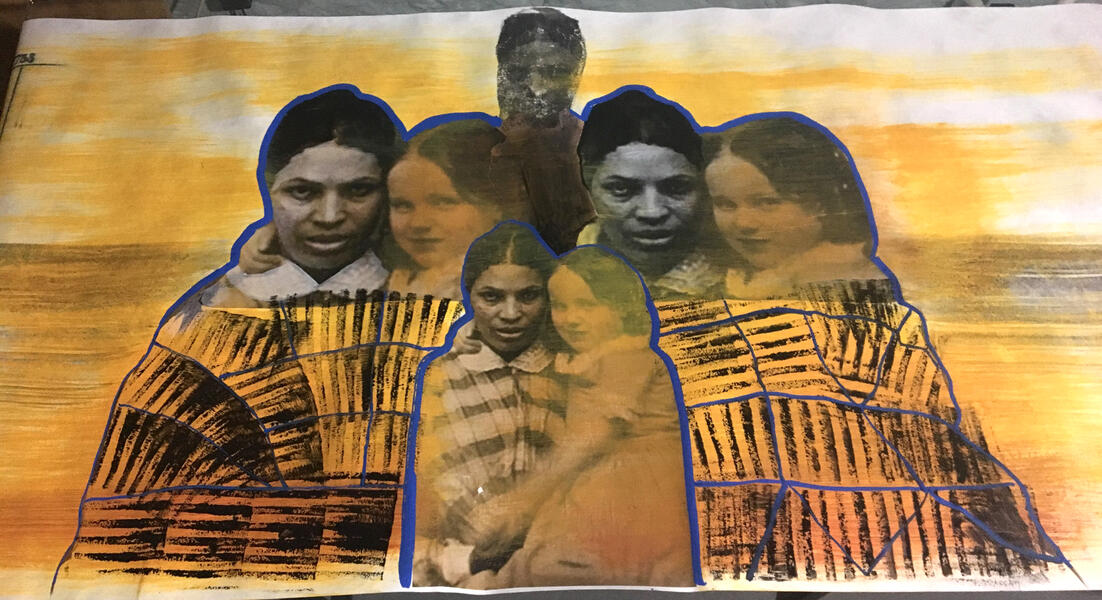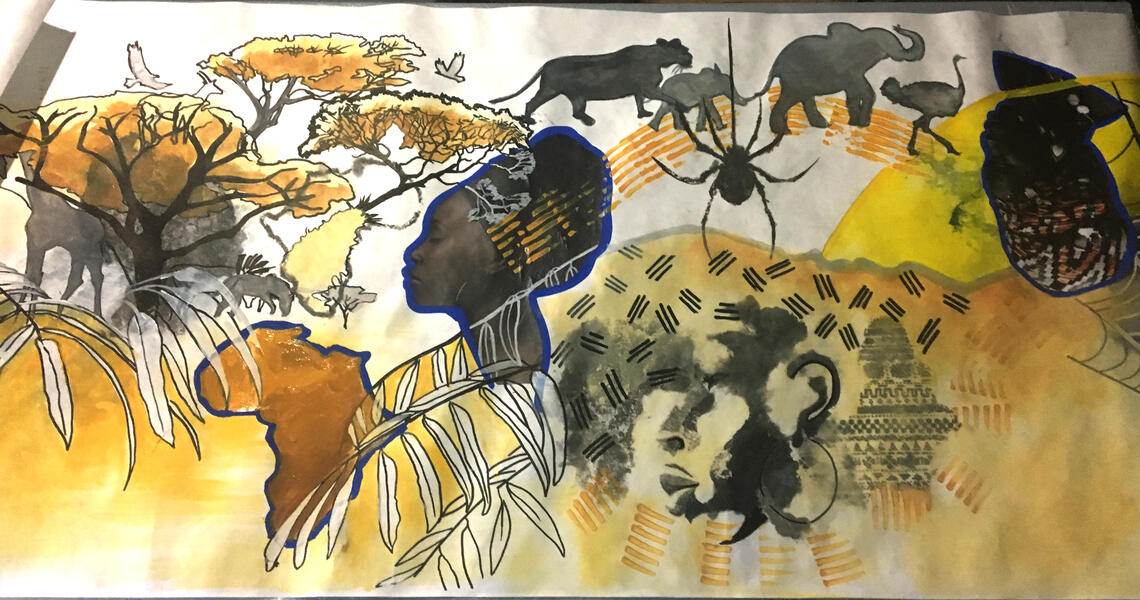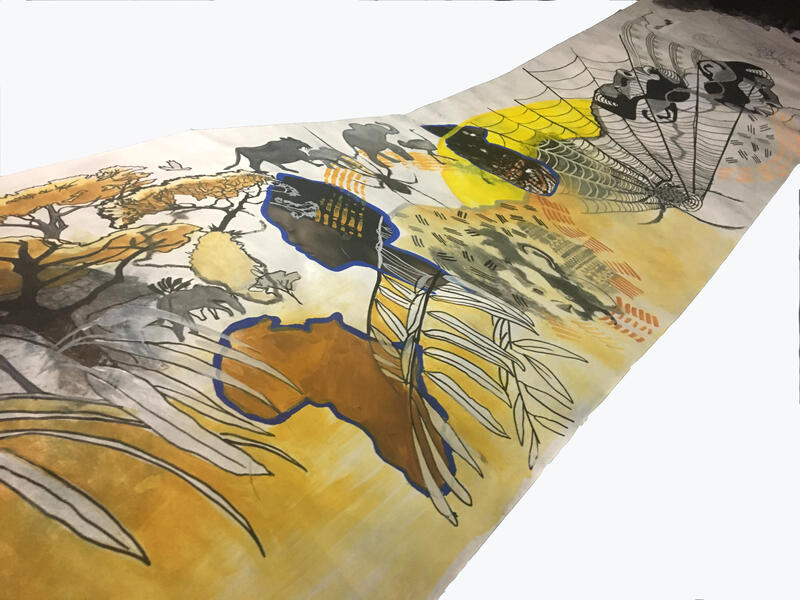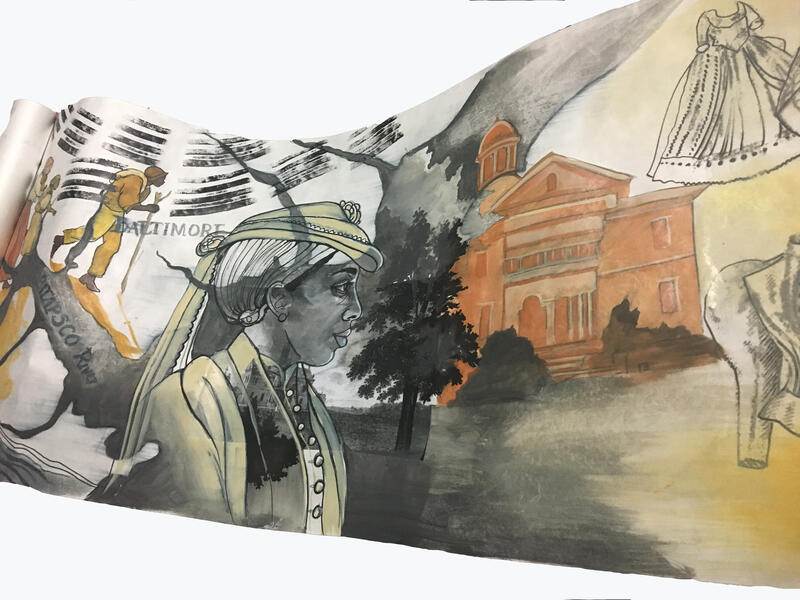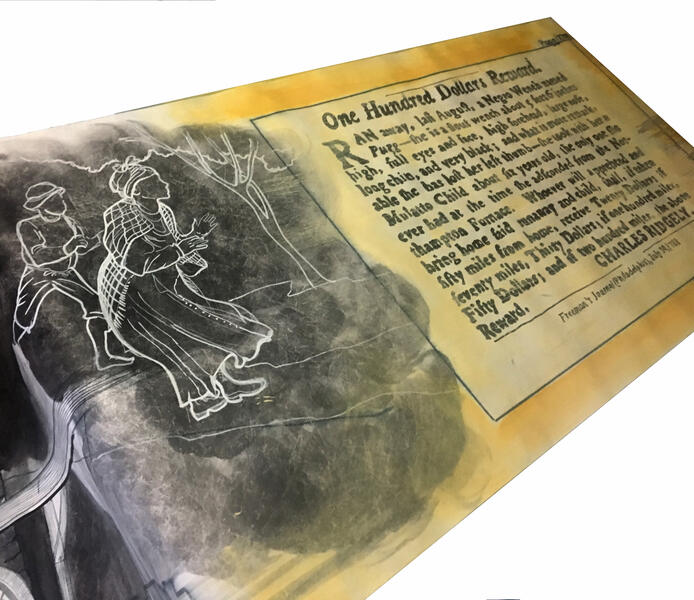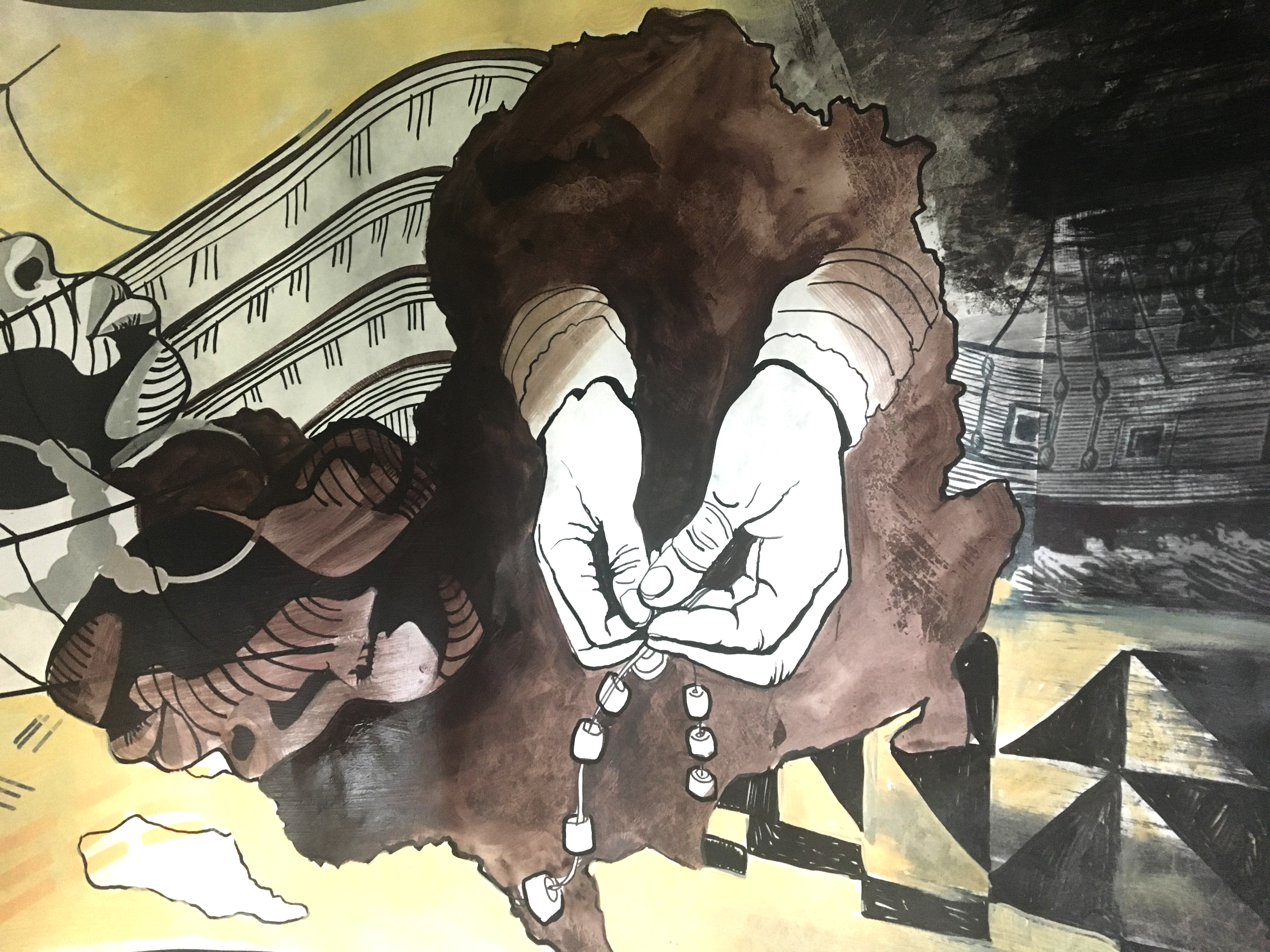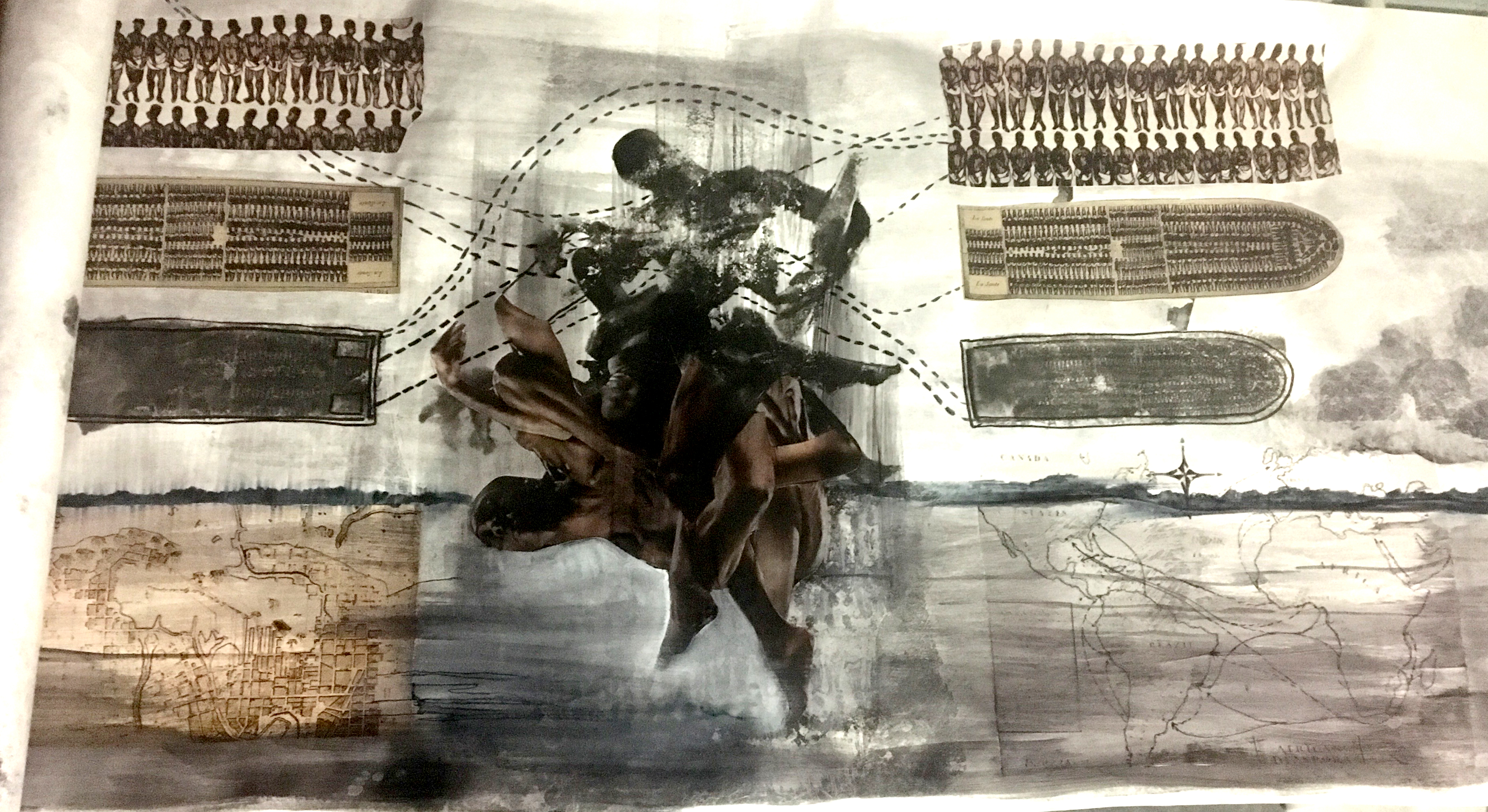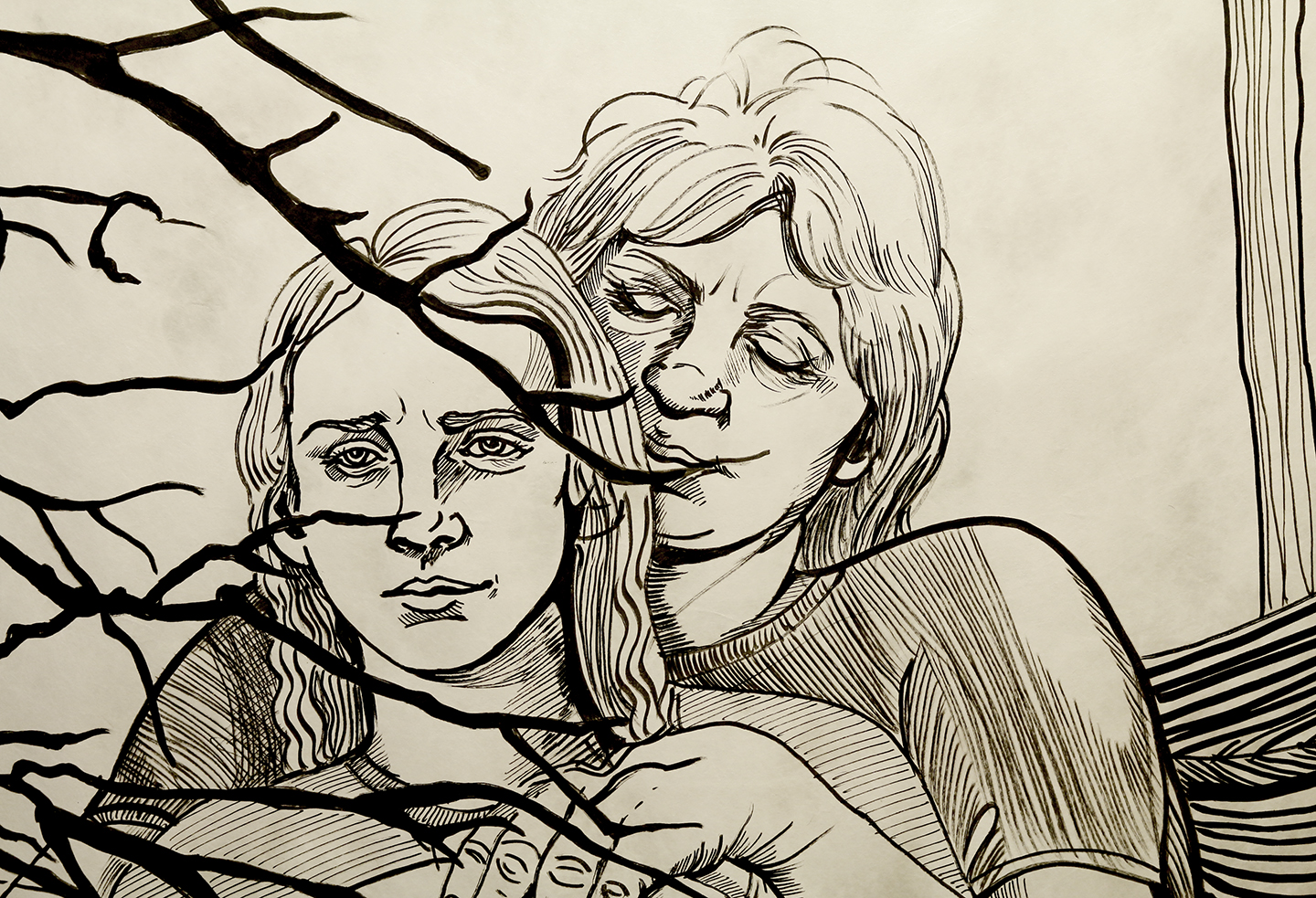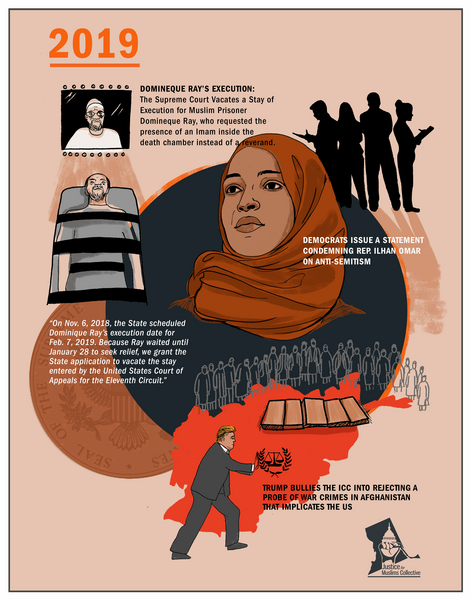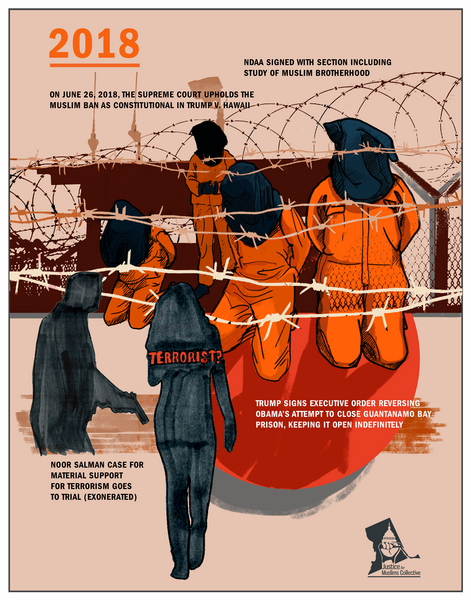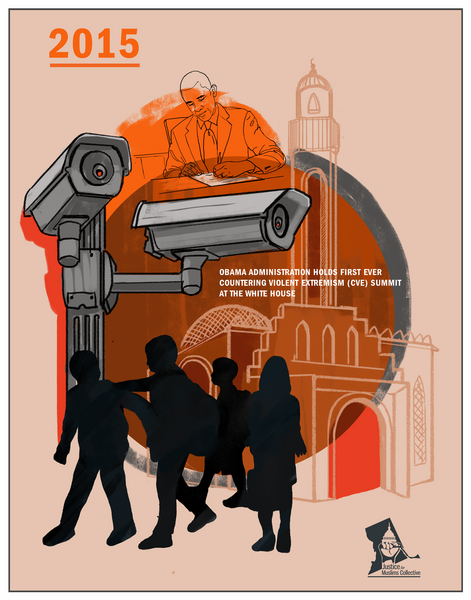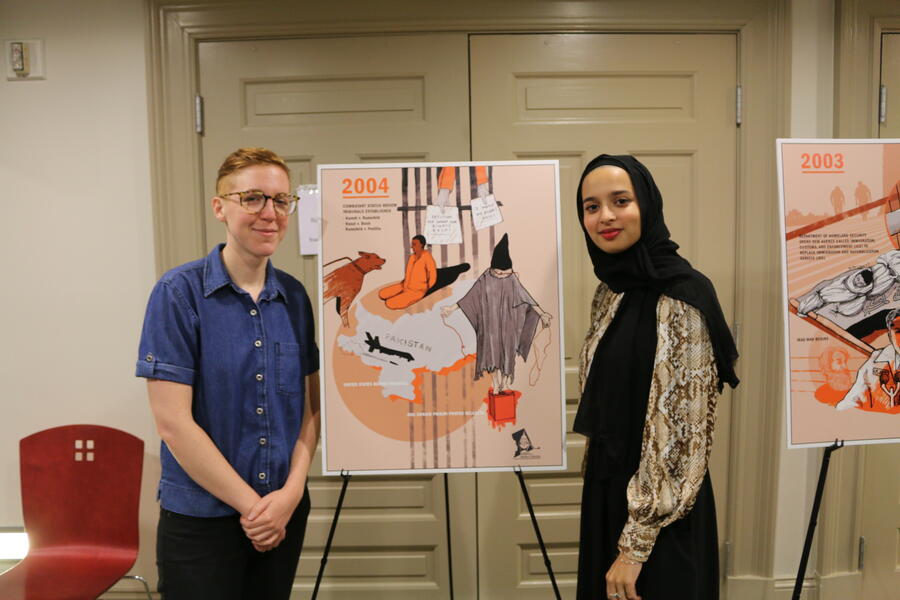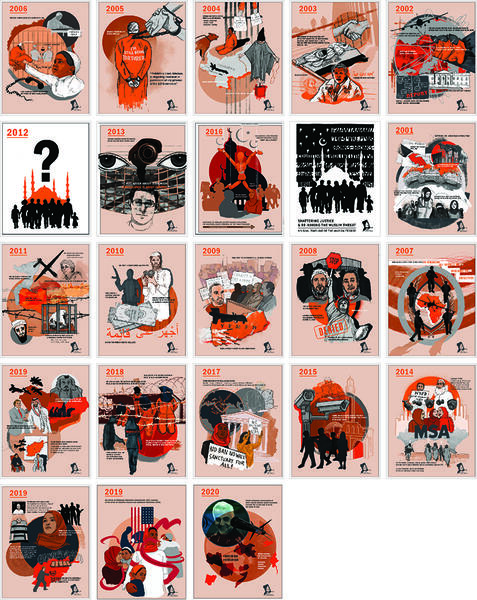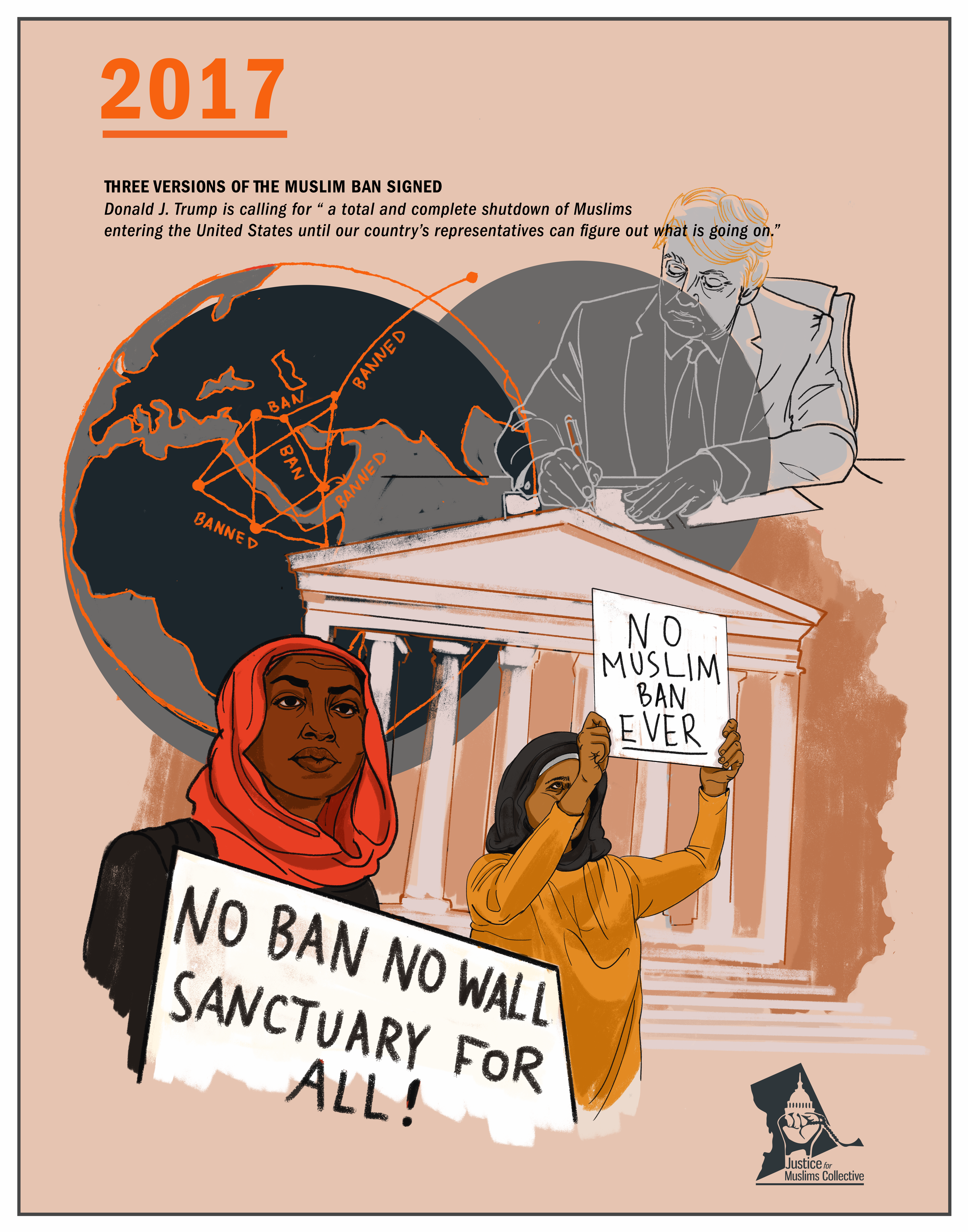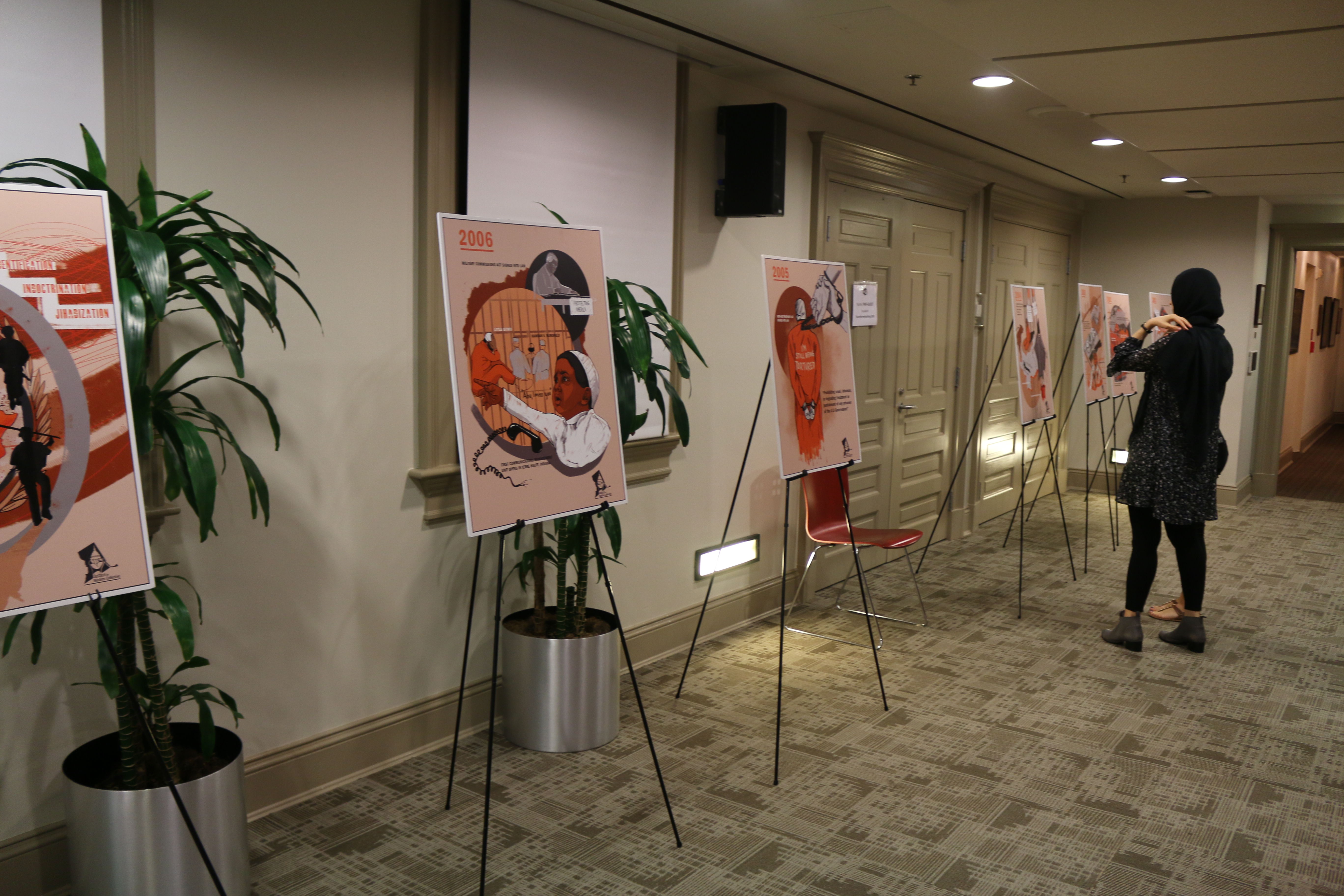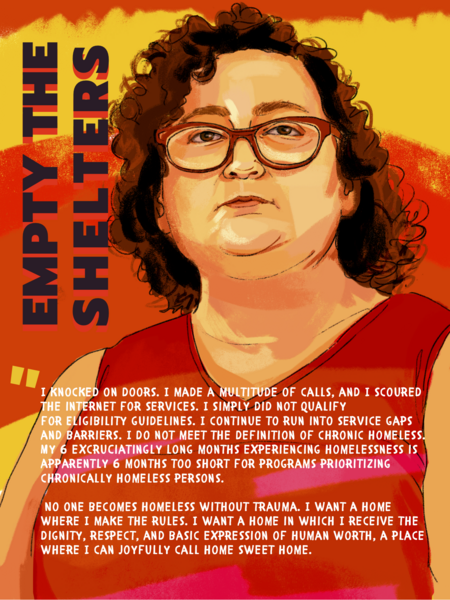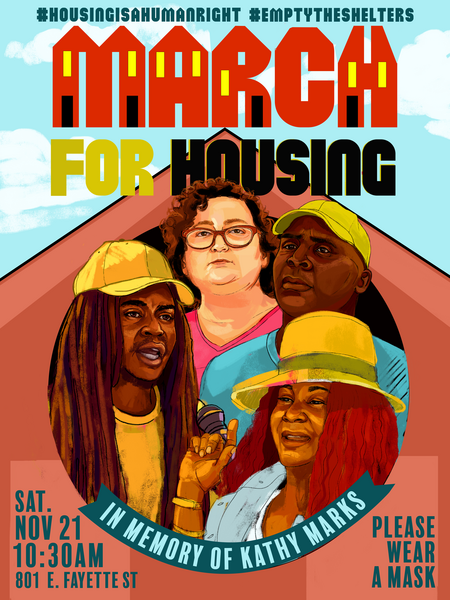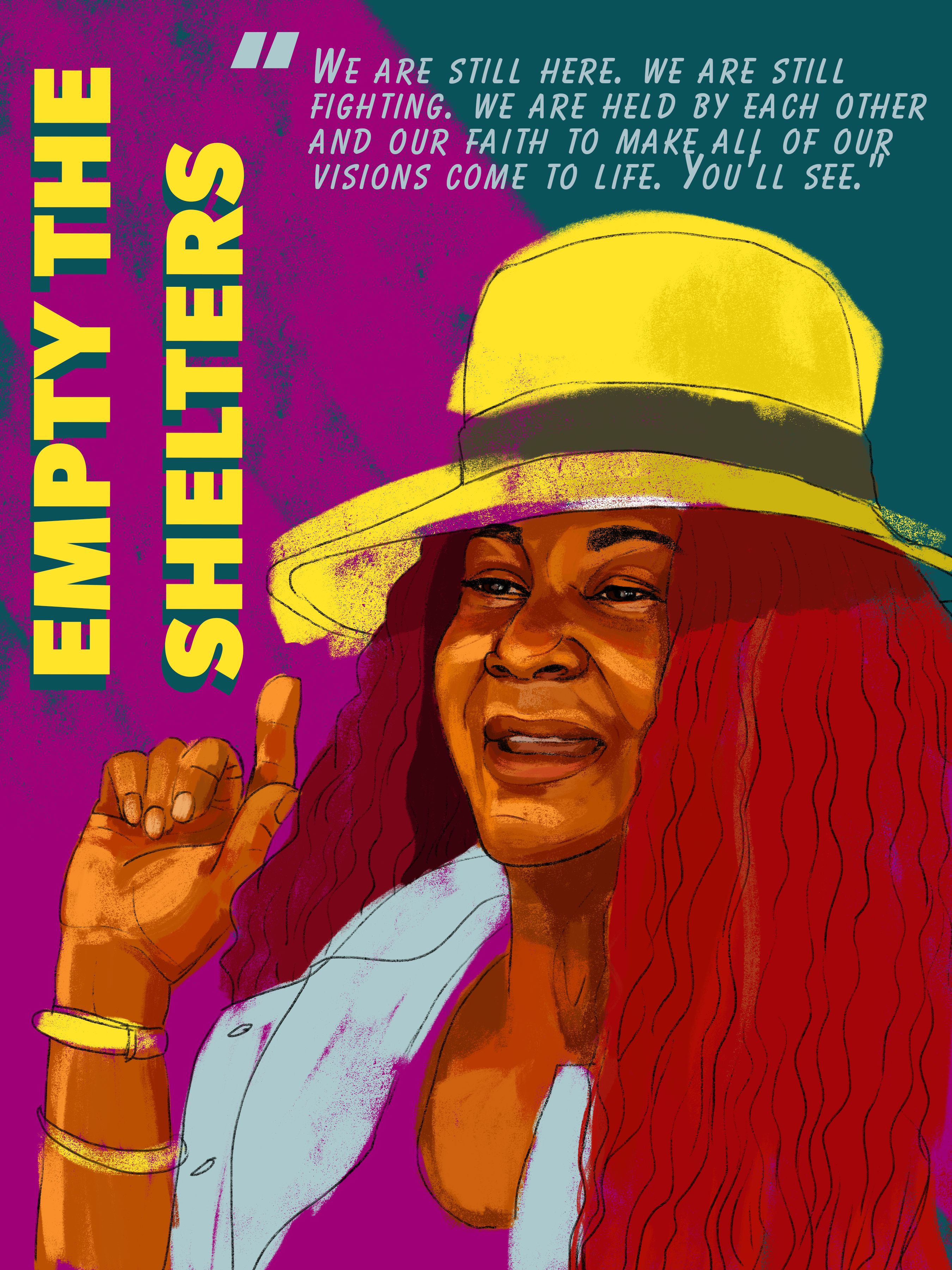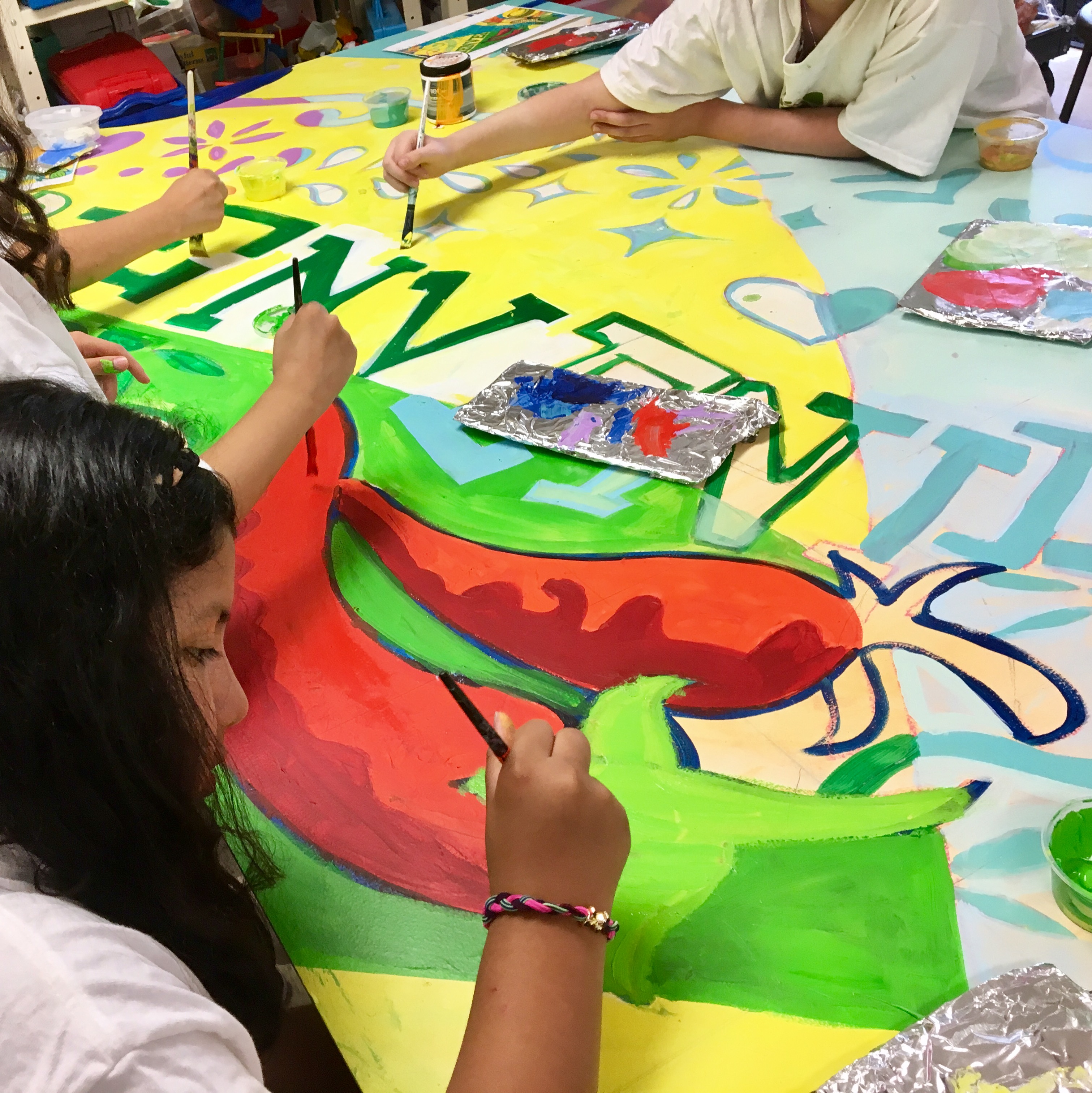About Maura

Honoring site-specific needs of each community, Maura Dwyer designs vibrant, collaged, visual stories that weave together histories, personal narratives, and political issues of our time to imagine a better future together. Maura’s public art and teaching artist practice is a collaborative process that supports collective reflection and action. When invited to dive deeper into a topic to better understand the nuances of a narrative, history, or place, she transforms ideas… more
Ruminations on Red Geographies
A Crankie is one word for a long, visual scroll that is physically cranked by the performer to tell a story, often accompanied by a song, script, or folk-tale. Versions of illustrated scrolls that use shadow puppetry exist in many other parts of the world, with a long history in Southeast Asia, and a traditional practice in Indonesia, called Wayang Kulit, to illustrate spiritual mythology. Artists in Bali continue to use this mediam to tell contemporary stories to rural communities.
I am calling on inspiration from crankies told in the late 1800's when new Europoean immigrants coming to so-called America created them to tell stories about their home country and perform them in churches, town festivals, and ceremonies, often along with folk songs. They are also used as a form of street theater, seen in South America and the United States by political action arts groups like the Bread & Puppet Theater based in Vermont.
More Details:
For this work, "Ruminations on Red Geographies," I was invited by the Baltimore artist Rae Red to create artwork in response to the color red for a devised, collective piece titled "Red is Real". I originally intended to perfrom this piece as part of the larger performance, but due to the pandemic, our performance dates were cancelled. After writing this piece in 2020, I was able to perform it at Current Space's outdoor stage, hosted by the Black Cherry Puppet Theater in Fall 2022.
At the time I was brainstorming ideas for this crankie, I was reading Mapping Desire: Geographies of Sexualities by David Bell, and wrote a 12-minute spoken word poem in response to that text, incorporating my own observations on the color red in my environment, and Euro-centric societal associations with red. The crankie script also weaves in reflections on my identity and family history, and pairs with a recorded soundscape from my surroundings.
This piece was first performed at the Black Cherry Puppet Theater, but is designed to travel and spark dialogue with different communi-ties about the variety of ways red carries different associations in different cultures and impacts our experience in public space.
Excerpt from Crankie Script (read aloud in spoken word):
Chromophobia: The persistent, irrational fear of color; an obsession with the absence of color-white-as the sublime ideal. But this absence only holds true for subtractive color. Additive color, like light, only achieves a pure white, with true green, true blue, and true red. (choreography: falling) The color red is a fall from grace into a world of consciousness and self-made. Like when aaron betsky claims queer (white) space finds the dark alley place where it can construct an artificial architecture of the self, a series of aroused networks charting our deepest desires, Audre Lorde responds: Our visions begin with our desires: we must know what we want, to understand what we are building towards. I want more than an alley but less than a hoard.
Red is a wrench for that building, tightening and loosening our understandings, stretching us to polar geographies, (choreography: stretching out) asking us to duo-dwell in overlapping circles: a venn diagram of prideful victories and shameful secrets, places defined by love and war, revolutionaries calling for anarchy and patriots sacrificing life for country, a closeness to godliness, (choreography: praying), glorious queer bodies resisting the fragmentation of lives and landscape, searching for a place to call home.
The European Renaissance summoned cardinals wearing regal red gowns downing the sacrifice of 70,000 crushed cochineals for one pound-of dye, and the slaughter of the Aztecs, whose dying traditions they stole along with their existence.
My first taste of christ occurs waiting in line for pastor martin to place his body in my mouth, the queasy anticipation of wrinkled soft finger tips brushed corner lips, landing where fifty tongues had just licked, the slip of the bronze edge. Lines of white-lace stuffed children wait to accept the eucharist and confess of their sins: knotted red fester of course hair, blood clotted kelp, pink scarred rip-tides, gleaming wet shells like salt-dripped wells of sweat, belly buttonned - pockmarked rock, your peach clam shell perched atop my white sand dune, red cheeks whipped smart, crusted algea legs swaying with the current, gasping for air, almost completely underwater. (choreography, underwater - looking up, breathing/gasping)
This body. (choreography: going limp) Losing color as we age like the lost coral we screamed about last night, as our public treasures disappear so too do our souls. My raw red eyelids are low-hanging rain clouds, the furrowed looks and lines between my creeping brows dig deeper, and yet - I hear conflicting lyrics: It takes a red headed woman to get a dirty job done goes the bruce springsteen song. Fragile fair skin, don’t go outdoors, the open sun sky will only bring you sores, Where is my pride?
In Irish my last name means “black” - dubh - duibhir - dyer - dwyer - a child of a cloth dying family. In America the English word for irish is white. Our claim to the Irish name remembered through slurred syllables also claimed solidarity with the north fighting police brutality while forgetting cries of those who lay on the other side of those red lines. Red haired families fleeing persecution, running toward the promise of peace and assimilation. Where is my pride?
( Choreography: hands raise to the pledge of allegiance) “We Americans claim to be a peace-loving people. We hate bloodshed; we are opposed to violence. Yet our hearts swell with pride at the thought that America is becoming the most powerful nation on earth, and that she will eventually plant her iron foot on the necks of all other nations. Such is the logic of patriotism... a superstition artificially created and maintained through a network of lies and falsehoods” - Emma Goldman. Where is my pride?
Is it found in the annals of anarchists who were thrown in jail for demanding the right to free their bodies and minds, later accused of red spies, thousands of immigrants deported for simply resembling “radicals”, hunted far and wide-free speech be damned-twenty eight states banned displaying red flags in 1920. Hoover labeled Dr. King a communist like the FBI calls Patrice Cullors a terrorist. The only flag this country could stand to fly has 13 red stripes for hardiness and valor, blue for vigilance and white for innocence. Where is my pride?
Is it found in the echoes of sports stadiums as my family cheer on their favorite red football team, , ignoring an on-going war on native ppl fighting for clean - water, still protecting ancestral land, still organizing to stop recognizing a holiday that celebrates genocide by one man, federal recognition a clear omission in this country’s mission to steal and demand with divine authority, everything at hand. How can we claim to never change a false name when our rivers and streets and landmarks preserve a native tongue, rooting us in a history that runs deep in America’s blood.
But names are not the only thing in the landscape that tell a story. Fear has created a whole style of architecture in urban design, where to be a pedestrian is to be under suspicion marks Rebecca Solnit.(Choreography-scared, protected pose) Think no tresspass signs, traffic lights, stop signs, boundary lines, warning signs, danger zones on map phones. Red tape that secures tall gates around riches like ditches, our moats for flooding gentrification, while coastal heatwaves sprawl fire across our paved polluted psychic, our histories of shame, aflame. We still have gaping red wounds to heal, I want reparations, not just reconciliation. We are recycling red scars in the landscape, a fissure into our future that beckons to be useful.
Is it found in the wisdom of our elders? “When we drop fear, we can draw nearer to people, we can draw nearer to the earth, we can draw nearer to all the heavenly creatures that surround us. Bell Hooks. Red as love: Our built environment controls our movements, our social exchange, our relationships, our desires, cities planned in right relation to the land are in right relation to our hearts. Are in right relationship to our bodies:
Like the red chakra of the base of the spine, used to heal in a time of crisis: steady, balanced, belong, nurture, sustain- these are the shades of red I want to world-build with. What would it look like if planners used principles like abundance, compassion, fluidity, and emotional healing to chart our maps? I hear the word connectivity often, referring to the routes our built environment allows for pathways to get from point A to point B, but I wonder- what would connectivity mean if we meant it as a means of fostering relationships of transformation through trust-building, like the ancient sign of welcome in a red door applied on every foundation, signifying come inside, you are safe here.
We will lap up your tensions, swallowed deep in our pit, where they’ll digest slowly to stay with it. Rest and seed your woes, I will devour your faults whole and wait for them to grow in the space of forgiveness, weaving our traumas together like kneading layers in the earth’s crust- Rebirth them as a familiar stranger we know how to hold. A part of our family. Our children of many. Free to frolick in public space, not just alleys. The straightness of our streets is an artifact, not a natural fact. Where is my pride?
The nuclear family is dissolving. We are the makers of each other- we could learn collectively to act like it. In this world building, cities are designed to hold -not cage- bodies, designed to heal - not herd- bodies, and we are held in many, many different ways. In a western, colonized world, where even the simple act of walking in the public realm holds a European white, male helm, what has a history of difference and healing resisted? Space is a pressing matter, and it matters which bodies press against it...
I’m at The Castro for the first time:(choreography: looking up, searching slowly) The first red I see is the looming bank of america sign wrapped around three sides of corner history we’ll never get right. If the gay agenda settles into hillside homes, maybe truly public queer space must “remain ephemeral— uncovered and recovered by years of renovations, lingering only in the memorial.”
Kimberly Crenshow states: Intersectionality means being able to attend to not just unfair exclusion but also unearned inclusion. We must observe the ways our pride reproduces injustice, then take action: see red. (choreography: action stance, red light) Our shades of red are embedded in this cross section, start at the palest pink to the deepest burgundy, floating somewhere between self and society, villain and victim, the body and spirit, man and woman, conflict and truce, lover and friend, this life and its end. Shades of red entwined: neither, both, other, us, as we are in our differences. As we are in our own mess making, searching further distances for the white clear light of knowing, dripping red drops of wondering along the way.
We Call It The Red Line
More details:
This crankie summarizes my father's short stint in the east-side fight against the expressway in the 1960's and 70's, or what we now call: the Highway to Nowhere. As a public artist with an interest in city planning and a desire to connect my arts background to organizers working to shift policy, for the last three years I have volunteered with the Baltimore Transit Equity Coalition (BTEC). This grassroots, Black-led organization grew from the cancellation of the Red Line light rail in 2015 to organize Baltimore around reviving the vision for public transit with a focus on equity.
This crankie started with a series of interviews from BTEC members and my family, along with archival research through the University of Baltimore and recent published scholarship, such as "Baltimore Revisited: Stories of Inequality and Resistance in a US City", published in 2019. It summarizes our history of segregation via redlining and urban renewal policies, connects to the current transit justice movement to revive the Red Line, and reflects on the role my family and others' played in that process.
Excerpt from Crankie Script:
Opening sound: Vintage 1950’s highway commercial: “More and more cars, more cars will be bought, and every one of them will have the right to our roads and highways….”
(Spoken word-esque, with a rhythm, varying the pacing from fast-slow-fast)
Cars have more rights than humans these days.
It is 2020, and what they didn’t tell us was- more pollution, more asthma, more concrete, more run-off, more emissions, more carbon, more demolition, less species, more petroleum, more drilling, more broken treaties- more wars, fought on this land and overseas, in order to fuel the american dream of steam, of supremacy, of clean air, grass-green, look at all that space, of neighbors who justify the desire to escape.
People still rationalize roads as fulfilling a fantasy but what is the scale of this hegemony? Zoning for small, severed single family boxes conflicts with the common good in a city in dire need of more affordable housing.
It is 1792. Residents are at odds with their city planning like Baltimore at odds with Annapolis when it got its first charter: For we were not founded by idealists looking to barter, but by overlords protecting their southern plantations from a growing city of freed Blacks with skills and ships and grain and motivation- to take back the power that was denied for a century, no wonder representation was considered crazy, until one of the largest cities in the country was given - just two seats - in a House of eighty.
It is 1949, and my father is born on Fleet Street in Fells Point in a home with no indoor plumbing or heating, with 50 children on one block who play stickball in the alleys. His living room was outside the front door, life spread into the streets, that served people before-cars, before giant companies like GM took over the electric street-car system.
I hear a call for Complete Streets, for electric motors- I say add complete light rail, make it multi-modal, we are not reinventing the wheel, we are just revivalists, repeating old cycles with millennial cyclists. Auto lobbyists leveraged our obsession with safety and our precious babies getting hit by speeding cars- look both ways before crossing the street is a recent lesson, what we should have said then was, look both ways before our city gets divided by a massive highway.
It’s 1987, and there’s a brass band playing at the grand opening of the extension of the baltimore metro to owings mills, designed to bring county folks to the city to shop.
Audience question: How many here have used the metro in the last year? Five? Ten?
The metro system was originally envisioned as 6 rapid-transit lines radiating from a central city loop, 71 miles long. By 1971 it was cut to 28 miles. When they started building in 1983, there were only 7.6 miles left. From 71 to 7, rail lines disappearing like the amount of stars we can see in our skies at night, what was once a sparkling constellation is now just a fading gleam - light years apart.
A recent study from Harvard experts found the single strongest factor affecting the odds of a child escaping poverty isn’t the -test scores. It’s the percentage of workers in that child’s neighborhood who have long - commute times. I live in Hampden, 5 minutes from my job by car, 15 by bike, 25 by bus and light rail.
It is 1966 and Hampden missed blockbusting, along with my father’s neighborhood near fells point. If they beat out the Home Owners Loan Corporation scheme, they just had to wait a few years to see the value of their homes increase, to the point they couldn’t afford rent or taxes and owners were selling and joining the masses.
When we think of white flight we think of the 1965 Federal Aid Highway Act, and the FDA’s subsidized mortgage policies in white only burbs. But in Baltimore, we were ahead of the game. It is 1891 and we are both a champion of the electric streetcar and racial covenants. The Great Migration is adding to a relatively large number of African Americans - streetcars couldn’t take you to the true country side, but they could shuttle down Euro-modeled fenced- in garden mansions just outside the city line.
There’s a lot less people now so traffic calms down, but there’s no jobs on the east side like back in the day, whose going to ride the rail line when no one’s in the streets?
But they are in the streets, I say.
It is April 27th, 2015 and I am at my grandmother’s house in Hamilton folding laundry, and across town more than 15 buses are stalled at Mondawmin Mall. demanding children get off and wait in a crowded parking lot to face rows of cops in riot gear. My friend took home terrified students that day because that was the only way to get home. She says the uprising was started by a shut down of transportation. I say yes - but put the start day closer to emancipation proclamation - a false hope of citizenship that is still owed by this nation....
It’s 1970, and my father is sitting next to Barbara Mikulski and Gloria Aull, singing at City Council President Scheafer about building a highway from I-70 in the west, through downtown, and along the water to the east.
(insert recording of interview with father and festival song)
'They used eminent domain, they just took them over like they did in fells point and canton. They tore down a bunch of houses in canton by saying you have a year to move out and here’s $5,000 for the house, and then along Franklin- Mulberry they had done that 10 years earlier. The fight against the expressway led to a lot of positive stuff in southeast baltimore though, people thought it was going to be a dump because in their mind, with the expressway going through, the whole area would turn into a slum. The society for the preservation of fells point and fed hill put out a lot of money and lawyers to file a lawsuit against the highway, and they got it stopped.'
Pause, go back to spoken word to change the pace:
In Southeast Baltimore, fighting the road was a beginning, not an end. What it was called then was a resurgence of ethnic power. Polish, Italian, Irish, Greek, Lithuanian festivals, children of American parents who ignored their heritage for generations to assimilate into whiteness finally understood that’s where their rallying call echoed, into the city hall chambers of immigrant identity, spurred by the civil rights freedom movement, reclaiming a narrative that didn’t belong to them indefinitely - this kind of defiance made new liberals- hoping to avoid contradiction between community preservation and racial inclusion - fall to silence.
When your leader argues that groups should organize in their separate spheres racially and only collaborate when issues overlap, the answer should be: they will always overlap. The answer should be: you do not fix a neighborhood first and society second without leaving others behind.
It is 1966 and my father is about to graduate high school and downtown, the city council is considering tearing down 880 houses through the 77% owner occupied Rosemount community. While the federal government used highway expansion as a moral method to dissolve the unwanted, this neighborhood was strong. The voting rights act has just passed and my father thinks, 'maybe that will give black people the legal recourse needed to stop this road.' Wrong.
It is June 25th, 2015, and Maryland’s newly elected governor just announced the cancellation of the shovel ready, east-west, third rail line, studied in planning documents since the 1960’s, going from Social Security in Woodlawn on the west side, to Bayiew on the east side, bringing 10,000 jobs and rapid commute times- remember, the #1 leading cause of poverty- We call it the Red Line. Slated to become the transit successor of the aborted east-west highway to nowhere, in one decision made by a man that this city did not elect, the opportunity to give that scar of concrete any purpose evaporated, and with it the promise of access and investment along rail stations. Samuel Jordan, director of the Baltimore Transit Equity Coalition, was reading the Baltimore Sun, stunned, seeing 13 years of planning with a coalition of 19 community groups along each station- vanish, gone. As if Annapolis was pulling us back to 1792, but the wealthy landowners and businessmen were just giving us a preview of more to come, you’d think they’d understand by now the price fully paid, the gift from white supremacy is underdevelopment for everyone.
Samual Jordan’s quote:
"The society’s prosperity, it’s growth, it’s ability to elevate its members, is also associated with its mobility, the abiltiy to circulate in society without restrictions. That where its ideas, its contacts, its energy - comes from. Baltimore is in need of its engine, it’s the undercurrent in a vibrant society, the circulatory system that keeps the entire system working. We aren’t conscious of having to breath, we aren’t conscious of having to pump blood through our system. We shouldn’t have to think about public transit being available to everyone. Let us breathe.”
-
Performance Documentation of "We Call It the Red Line"This is a 17-minute recording of the live performance of "We Call It The Red Line" at The Creative Alliance's Crankie Fest in January 2020. Assisted by artist Emily Schubert and documented by Aaron Barlow. All visuals and sound designed and produced by Maura Dwyer.
-
 Performance at Creative Alliance's 2020 Crankie Fest
Performance at Creative Alliance's 2020 Crankie Fest -
performance still
-
crankie still showing redlining
-
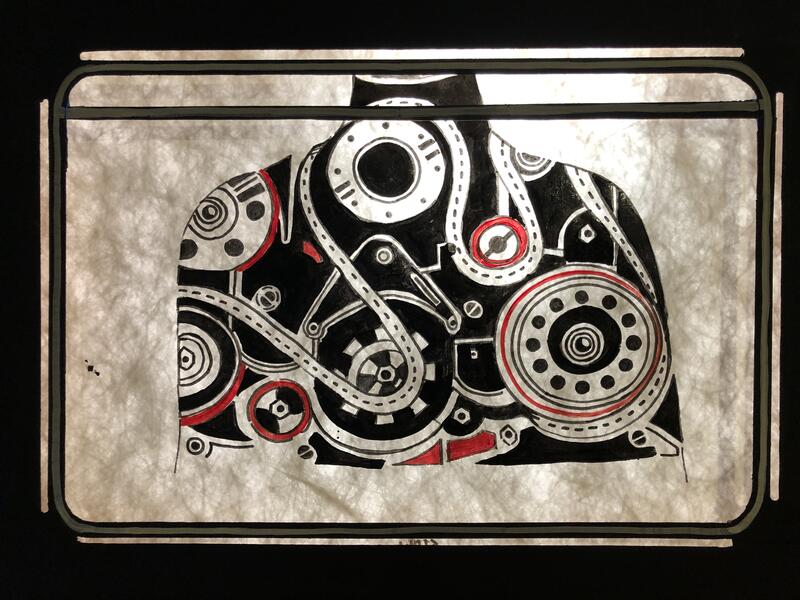 Still from "We Call it the Red Line"still of animation
Still from "We Call it the Red Line"still of animation -
detail
-
detail
-
detail
-
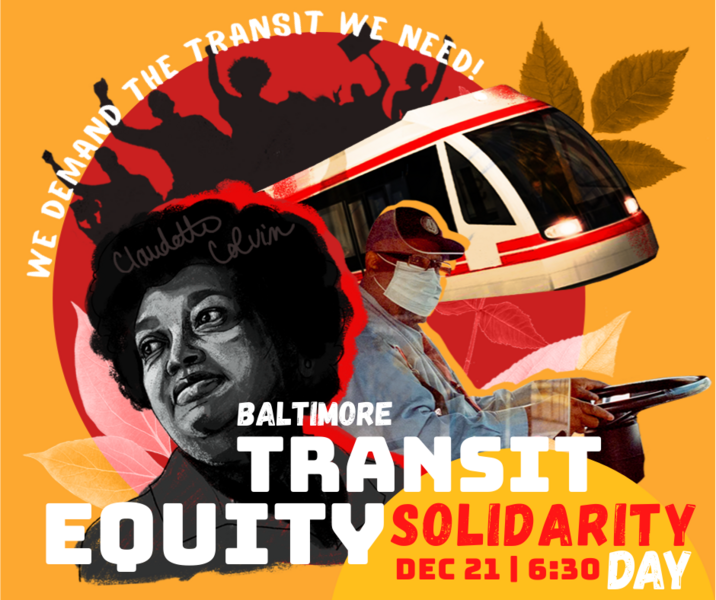 Visual for Baltimore Transit Equity Solidarity Day 2020
Visual for Baltimore Transit Equity Solidarity Day 2020 -
 behind the scenes with shadow puppets
behind the scenes with shadow puppets
Neighborhood Lights 2018: Remington and Brooklyn/Curtis Bay
Materials: projection screen, three over-head projectors, acetate, tyvek. The images are cut out and layered on three different overhead projectors at the same time to get a sense of depth and movement. For each Neighborhood Lights event, three puppeteers performed live while I read narration, and the band Trucker Talk played live on stage next to the screen. There were opening acts from local poets, puppeteers, and musicians, community tabling for resources, family activities, and local food vendors. Please see credits for a list of all the people that contributed to this project.
Workshops: Along with the Opening Night Event and projected shadow puppet performance, each neighborhood project had a workshop component to teach a skill. For both neighborhoods, we made laser-cut, LED-lit lanterns with drawn silhouettes of iconic imagery from the area on each panel.
-
Neighborhood Lights 2018 Micro DocMini Doc of Neighborhood Lights 2018 experience. Video by Human Beings Productions.
-
Performance Documentation of Neighborhood Lights 2018: Brooklyn/Curtis BayBrooklyn/Curtis Bay Documentation
-
Performance Documentation: Neighborhood Lights 2018: RemingtonRemington Documentation
-
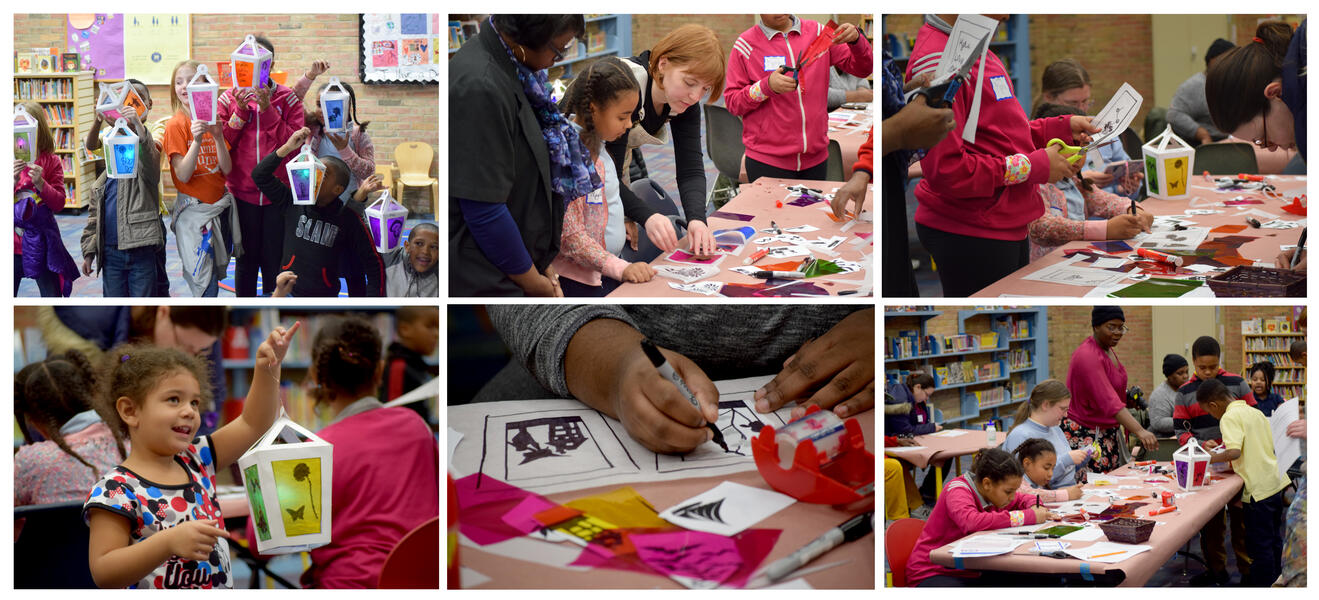 Workshop Documentation at Enoch Pratt Library: Brooklyn BranchWorkshop Documentation at Enoch Pratt Library: Brooklyn Branch Neighborhood Lights: Brooklyn/Curtis Bay Spring 2018 Photography by Destiny Watford and Greg Sawtell Materials: LED lights, acetate, laser-cut cardstock for the lantern frame, tape, sharpies, stencils, wire. On the night of the Opening Event for each neighborhood, the lanterns were hung around as decor and families were invited to take them home afterwards.
Workshop Documentation at Enoch Pratt Library: Brooklyn BranchWorkshop Documentation at Enoch Pratt Library: Brooklyn Branch Neighborhood Lights: Brooklyn/Curtis Bay Spring 2018 Photography by Destiny Watford and Greg Sawtell Materials: LED lights, acetate, laser-cut cardstock for the lantern frame, tape, sharpies, stencils, wire. On the night of the Opening Event for each neighborhood, the lanterns were hung around as decor and families were invited to take them home afterwards. -
 Opening Night Event: Brooklyn/Curtis BayPhoto documentation of the Opening Night Event of a "Century in the City", hosted at Garrett Park, Spring 2018. Photography by Nicole Caracia
Opening Night Event: Brooklyn/Curtis BayPhoto documentation of the Opening Night Event of a "Century in the City", hosted at Garrett Park, Spring 2018. Photography by Nicole Caracia -
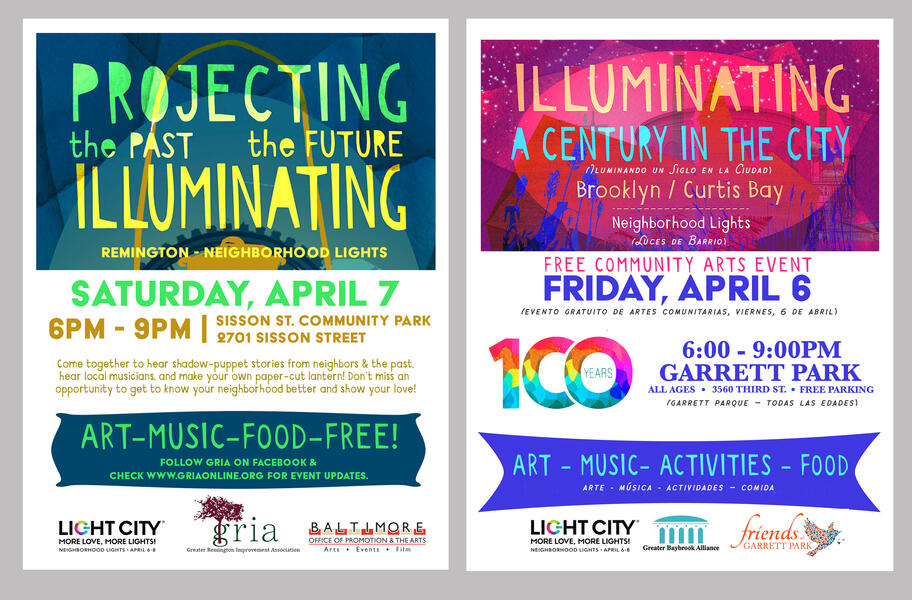 PromotionPromotion
PromotionPromotion -
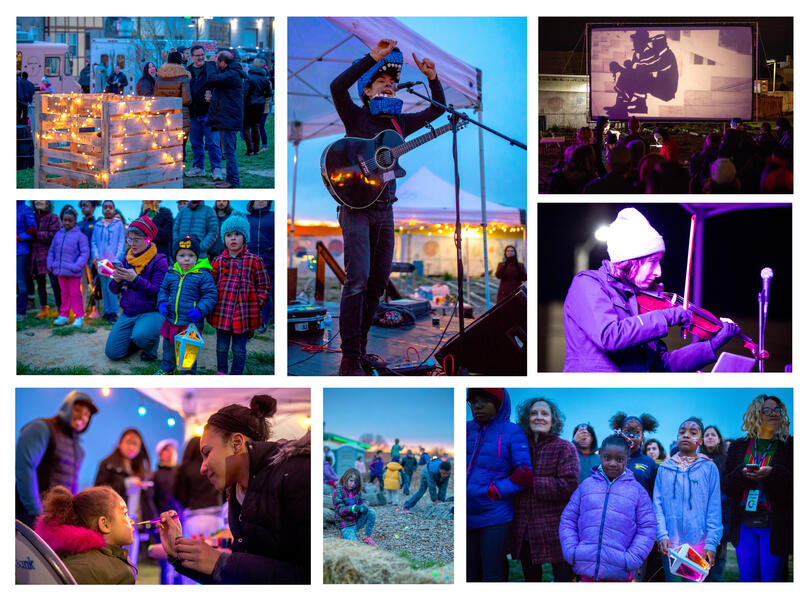 Documentation of Opening Night Event: RemingtonOpening Night Event: Neighborhood Lights 2018: Remington - at Sisson Street Park Photography by Crystal Dunn
Documentation of Opening Night Event: RemingtonOpening Night Event: Neighborhood Lights 2018: Remington - at Sisson Street Park Photography by Crystal Dunn -
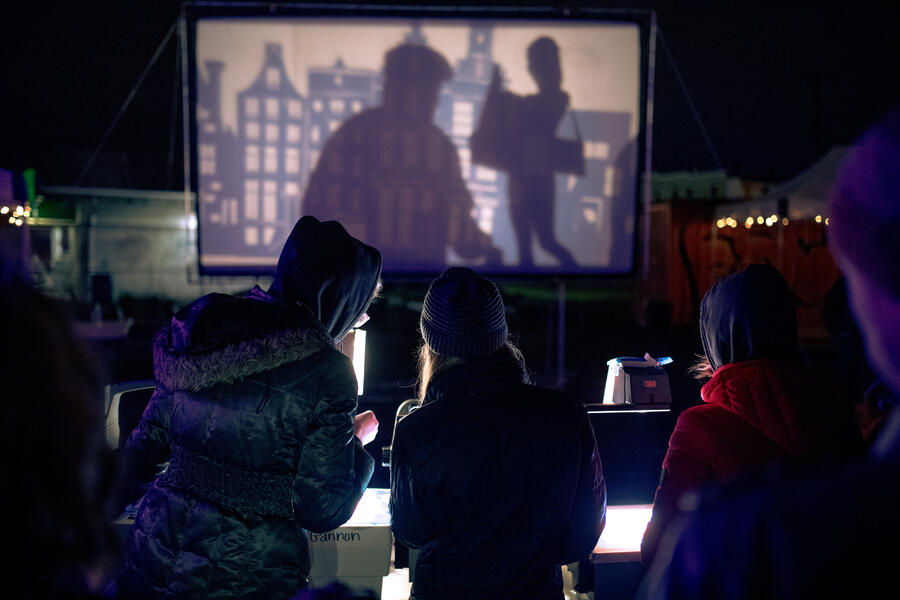 Event PhotoPuppeteers face the screen mid-way through the performance.
Event PhotoPuppeteers face the screen mid-way through the performance. -
 Performance Shotperformance shot of puppeteers: Devin Martin, Emily Schubert, Emily Hall
Performance Shotperformance shot of puppeteers: Devin Martin, Emily Schubert, Emily Hall -
 Performance ShotNarrating parts of the script for the crankie that weren't pre-recorded
Performance ShotNarrating parts of the script for the crankie that weren't pre-recorded
Neighborhood Lights 2017: Hamilton/Lauraville
Materials: Black lights, Roscoe UV paint, acrylic paint, wood panels, spray paint, stencils
-
Light City Baltimore Hamilton LauravilleMini Doc of the Neighborhood Lights experience Hamilton/Lauraville
-
Documentation of Neighborhood Lights 2017: FloraLumeDocumentation of the illuminated mural, "FloraLume," at the Opening Night Event
-
Hamilton Elem/Middle at Neighborhood Lights 2017: Hamilton LauravilleVideo documentation of a workshop held at Elena Johnston's middle school art class at Hamilton Elem/Middle. We asked students to respond to the main theme of the mural project with their own ideas, highlighting ways the area is sustainable, or answering what sustainability means for them.
-
 Workshop DocumentationDocumentation of the cyanotype posters 100+ families made at The Strand Theater in Hamilton.
Workshop DocumentationDocumentation of the cyanotype posters 100+ families made at The Strand Theater in Hamilton. -
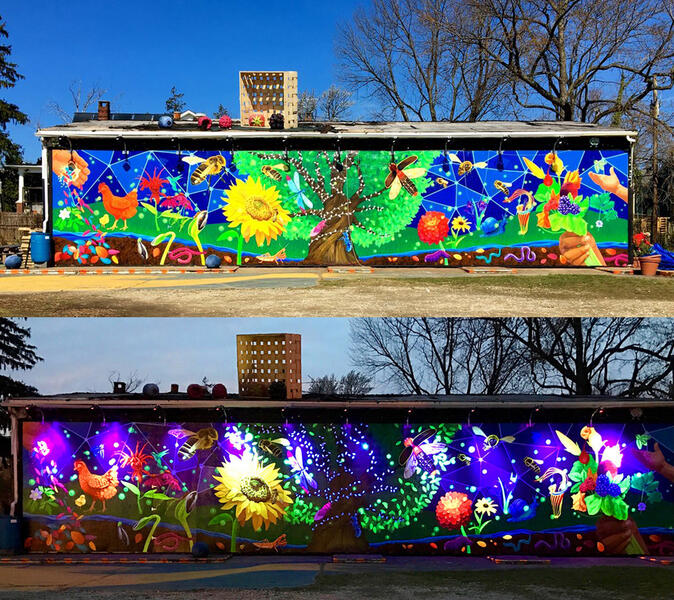 Day/NightShot of the mural going from day time to night.
Day/NightShot of the mural going from day time to night. -
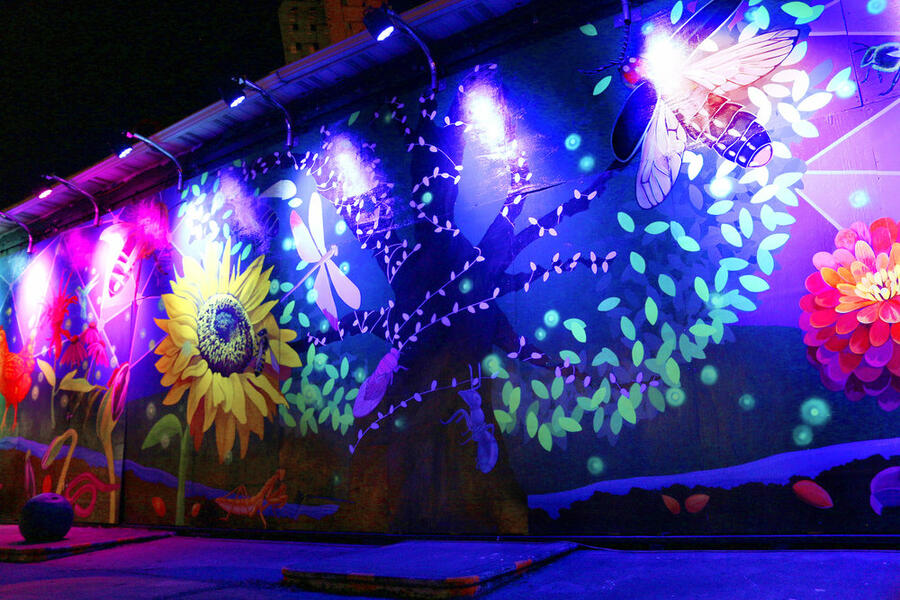 FloraLumeShot of the mural with UV lighting. Harford Road. Spring 2017.
FloraLumeShot of the mural with UV lighting. Harford Road. Spring 2017. -
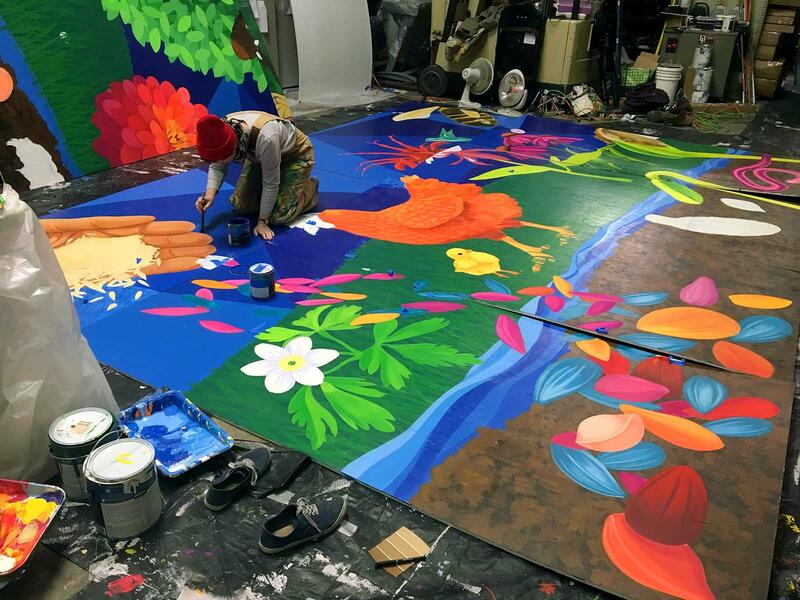 Process ShotWorking on the mural in a warehouse with UV clip lights to see the effects of the paint.
Process ShotWorking on the mural in a warehouse with UV clip lights to see the effects of the paint. -
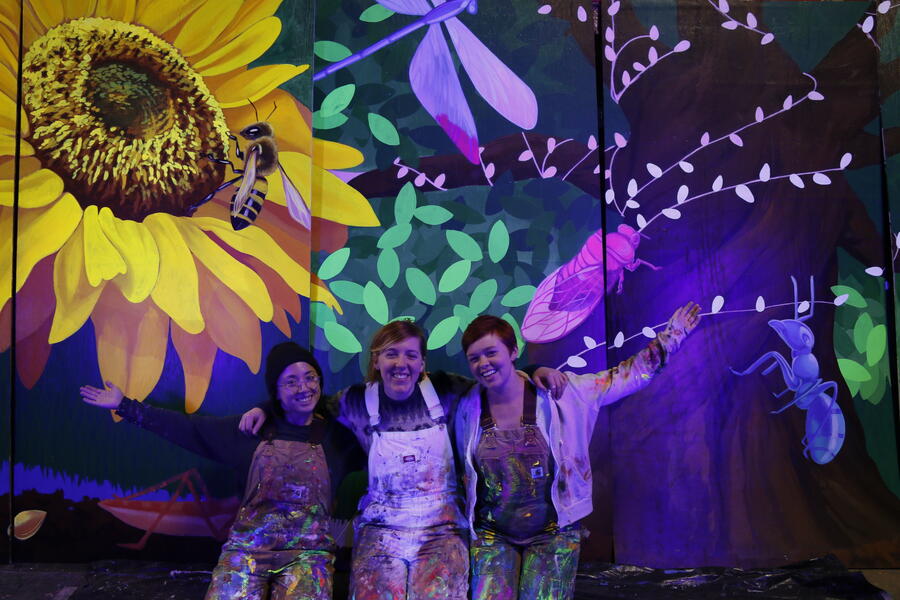 Painting Team (Spectrum Murals)
Painting Team (Spectrum Murals) -
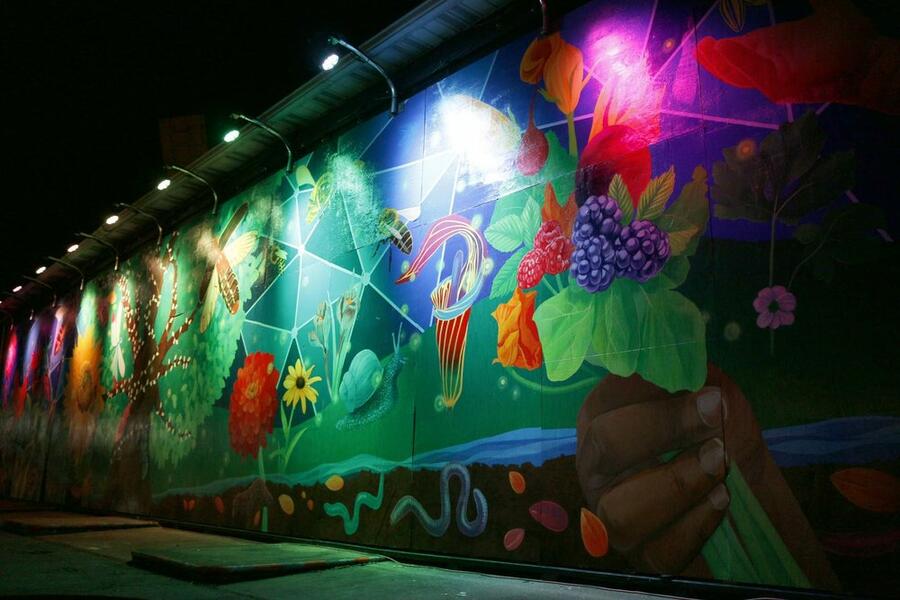 FloraLume
FloraLume -
Harford Road Aglow: FloraLume Unveiling Party
Sankofa: Moving Through Moments in Time
Description of the Mash Up Grant:
Aiming to build bridges between audiences and creators in Baltimore’s arts scene, the “Mash-ups” exhibition features the work of three groups who were awarded grants to create storytelling projects with collaborators they had neither known nor worked with previously. In just two months, these artists and performers pooled their diverse skillsets and experiences to explore new ways that storytelling can help connect silos and communities across the city. Curated by Nate Couser of the Artist Exchange Radio Show and Producer at the Peale Center, this exhibition is a presentation of their storytelling projects and what they learned from the process of creating with new partners.When I Was Your Age
Winter 2018
paint on paper, in hand-made crankie box
-
When I Was Your Age- Crankie by Maura Dwyer Song by Letitia VanSantVideo Documentation: 4:46 mins.
-
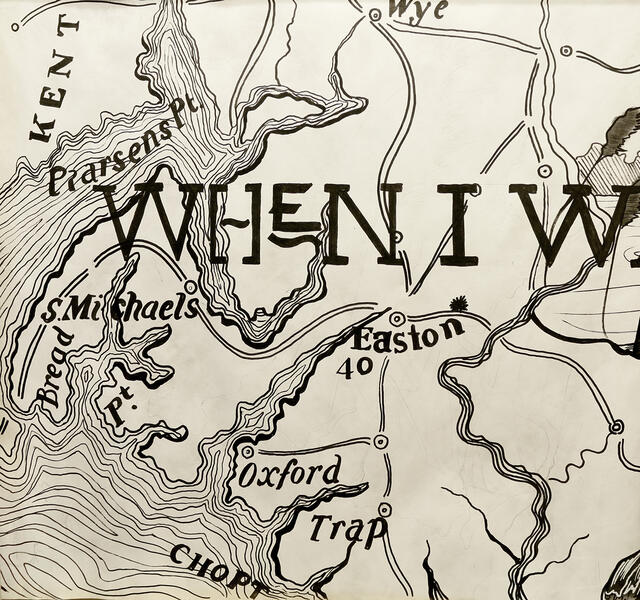 StillStill from the Crankie, "When I Was Your Age" , Winter 2018
StillStill from the Crankie, "When I Was Your Age" , Winter 2018 -
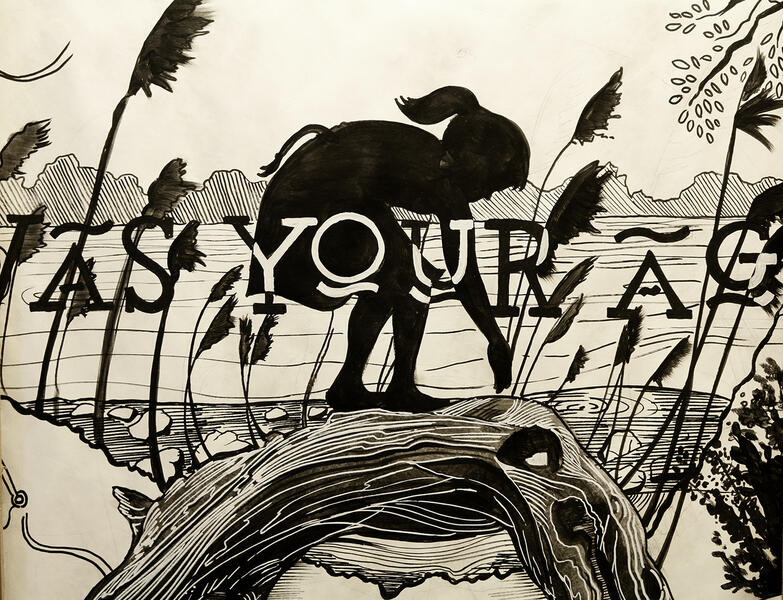 StillStill from the Crankie, "When I Was Your Age" , Winter 2018
StillStill from the Crankie, "When I Was Your Age" , Winter 2018 -
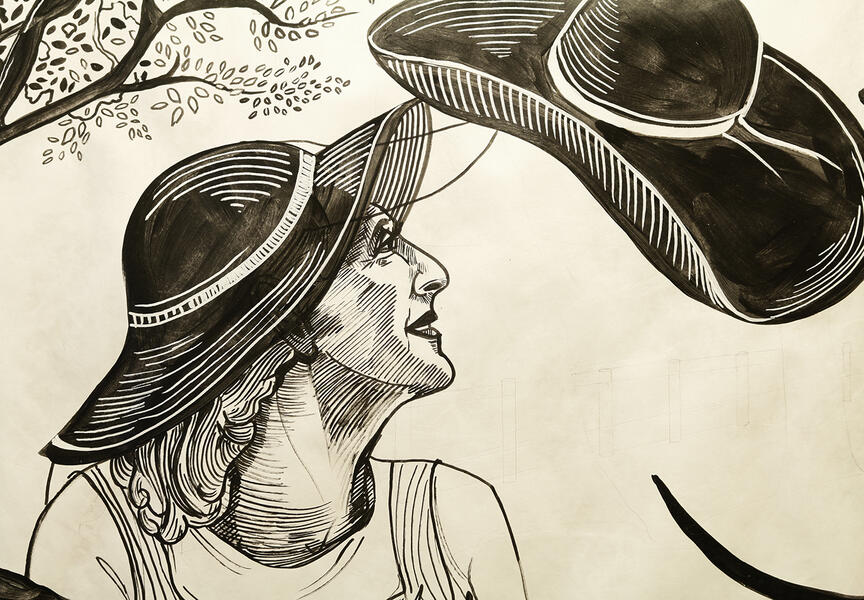 StillStill from the Crankie, "When I Was Your Age" , Winter 2018
StillStill from the Crankie, "When I Was Your Age" , Winter 2018 -
 StillStill from the Crankie, "When I Was Your Age" , Winter 2018
StillStill from the Crankie, "When I Was Your Age" , Winter 2018 -
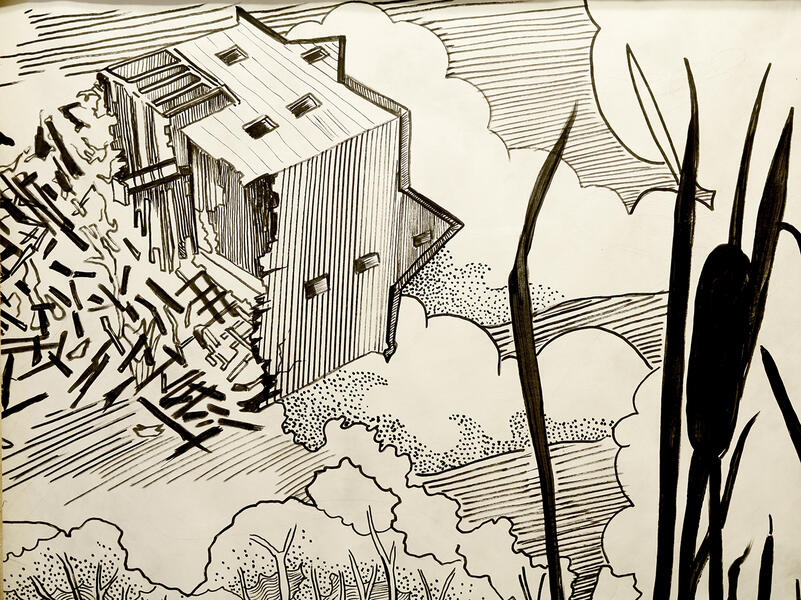 StillStill from the Crankie, "When I Was Your Age" , Winter 2018
StillStill from the Crankie, "When I Was Your Age" , Winter 2018 -
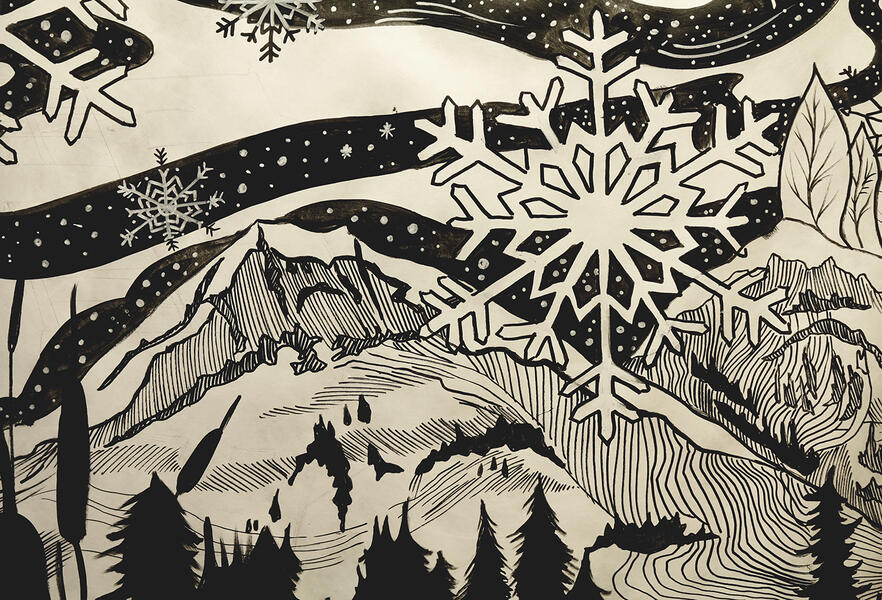 StillStill from the Crankie, "When I Was Your Age" , Winter 2018
StillStill from the Crankie, "When I Was Your Age" , Winter 2018 -
 StillStill from the Crankie, "When I Was Your Age" , Winter 2018
StillStill from the Crankie, "When I Was Your Age" , Winter 2018 -
Puppet Slamich Performance of When I Was Your Age: Oct 2018Song written by Letitia VanSant, performed by Maura Dwyer and accompanied by Philip McKnight. Black Cherry Puppet Theater, Baltimore MD 2018
War on Terror Timeline- Poster Series
The exhibit features a carefully curated poster series that outlines the many policies that have targeted Muslims since 9/11. All research was conducted by Dr. Maha Hilal, with visuals co-created by Muslim artist Zaynub Siddiqui and myself, focusing on design, composition, and color.
The goal of the exhibit is to highlight how entrenched Islamophobia has been throughout the War on Terror and the expanding apparatus of state violence. Complementing the exhibit, Justice for Muslim Co-Director Dr. Maha Hilal presented a keynote talk discussing the implications of the War on Terror, and the conceptualization of the timeline as a means of resisting state violence. In addition, The Sanctuaries DC, hosted an interactive session on cultural organizing. The series of posters continued to grow and be used in different political education settings.
Empty the Shelters Poster Series with Housing Our Neighbors
One of the HON leaders, Kathy Marks (pictured below with short brown curly hair)passed away during the process of drawing her portrait in October 2020. Below are remarks from Rachel Kutler, a HON volunteer coordinator, to remember Kathy:
"We are heartbroken to share that Kathy Marks, an incredible individual and beloved HON leader, unexpectedly passed away last week. Kathy joined HON this last year, and dove into the work like she had been a member of our family for years. She testified at our Truth Commission event in July, delivered petitions to City Hall, and was a true leader at the Pinderhughes shelter. She was dedicated to the work of housing justice - she never missed a meeting since our first HON meeting at the shelter, and organized her friends to attend too. Kathy was a talented writer and speaker. Before a meeting or event, she liked to write out her speech beforehand and practice it over and over again until she had it right. She was an encouraging teacher and helper, who wanted to see the people around her grow. We will remember her as a warm and calming friend, measured and defiant. She had a witty sense of humor and was not afraid to call you out, but always in the nicest way. She was kind and generous to everyone around her. We are devastated that Kathy lost her life in the shelter she was fighting so urgently to get out of. May her memory be a blessing and a reminder to keep fighting."
Teaching Artist Mural Workshops
Locations:
• Baltimore Youth Arts, Baltimore, MD • Western High School, Baltimore, MD • The Childrens Guild Monarch Academy Schools, Annapolis, Baltimore, and Laurel, MD • Summer Arts Learning Academy, Baltimore, MD • Fallston Highschool, Fallston, MD • Harford Day School, Harford MD • Thomas Jefferson Elementary/Middle, Baltimore, MD • Running Brook Elementary School, Columbia, MD
-
Maura Dwyer's Teaching Artist philosophy
-
IMG_9758.JPGHigh school students at Fallston High draw out their design using a grid on panels.
-
 IMG_9782.jpgHigh school student working on a mural in the classroom
IMG_9782.jpgHigh school student working on a mural in the classroom -
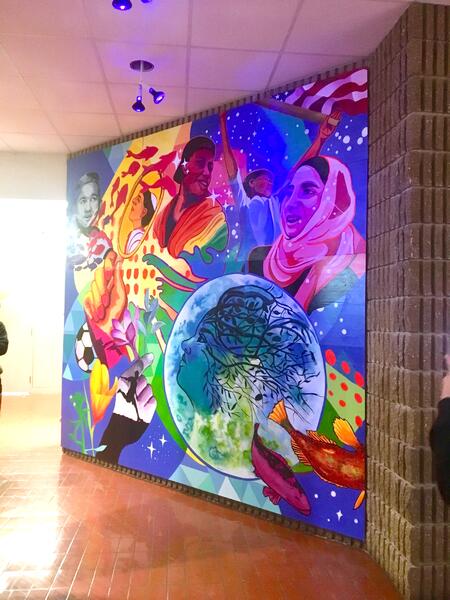 IMG_9881.jpgCompleted mural celebrating student identity at Fallston High School, 2019
IMG_9881.jpgCompleted mural celebrating student identity at Fallston High School, 2019 -
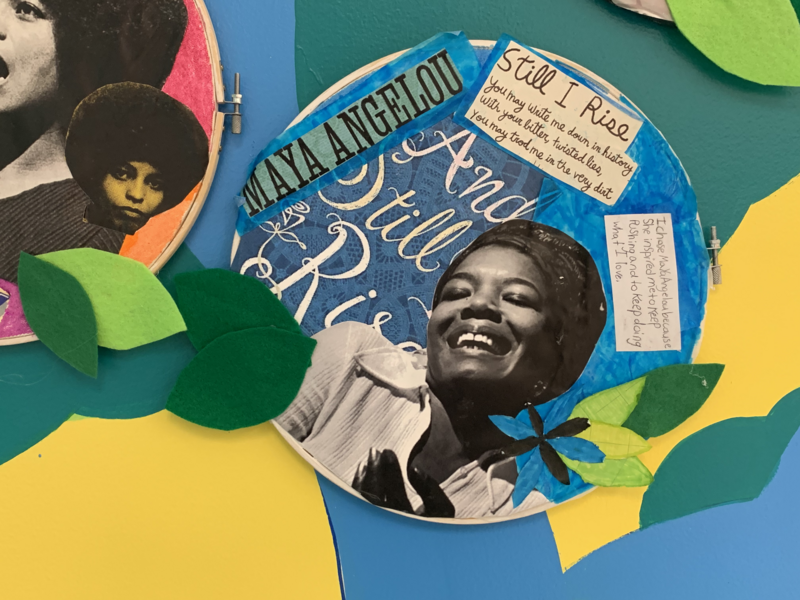 IMG_1879.pngDetail of a historical collage portrait mural middle school students from Thomas Jefferson Elementary-Middle completed during the pandemic in 2020
IMG_1879.pngDetail of a historical collage portrait mural middle school students from Thomas Jefferson Elementary-Middle completed during the pandemic in 2020 -
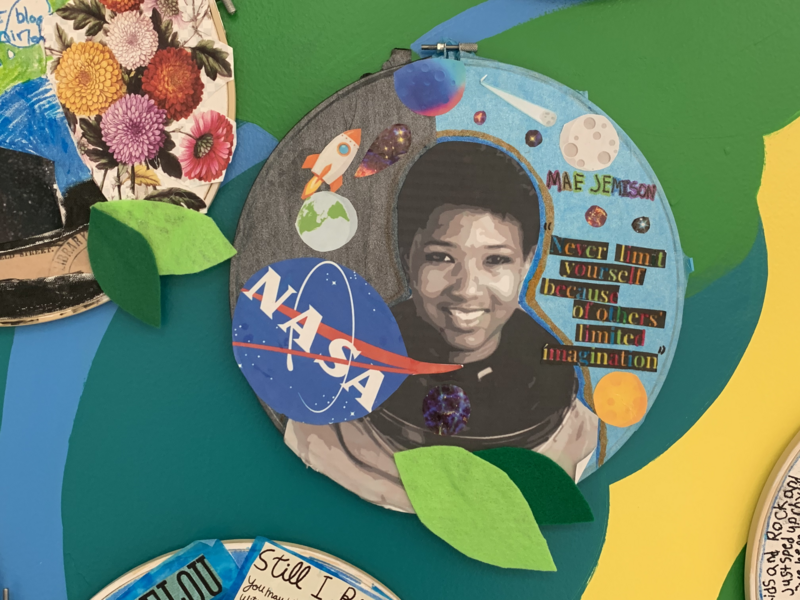 IMG_1878.pngDetail, Thomas Jefferson Elementary-Middle School, 2020, virtual residency (each student selected a historical figure to study and create a collaged portrait of with an at-home kit I designed, and I installed the mural after collecting each student's collage in the school library summer 2021)
IMG_1878.pngDetail, Thomas Jefferson Elementary-Middle School, 2020, virtual residency (each student selected a historical figure to study and create a collaged portrait of with an at-home kit I designed, and I installed the mural after collecting each student's collage in the school library summer 2021) -
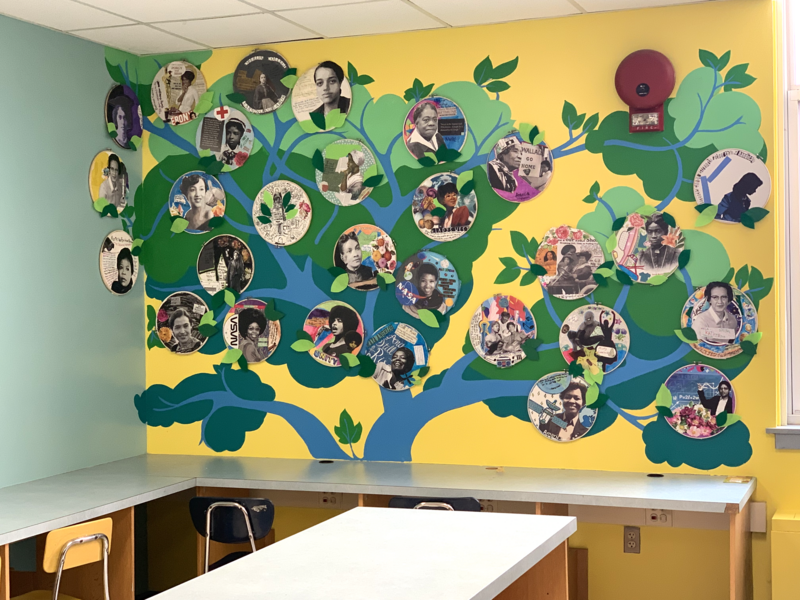 IMG_1868.pngCompleted Historical Tree mural at Thomas Jefferson Elementary-Middle School.
IMG_1868.pngCompleted Historical Tree mural at Thomas Jefferson Elementary-Middle School. -
 IMG_7614.jpgStudents working on a mural celebrating Mexican heritage at Running Brook Elementary, Columbia MD in 2018.
IMG_7614.jpgStudents working on a mural celebrating Mexican heritage at Running Brook Elementary, Columbia MD in 2018. -
IMG_7748.JPGAlmost completed mural by students at Running Brook Elementary
-
IMG_7519.JPGDetail of Identity and Family Tree Mural at Bay Brook Elementary School. Students created collage portraits of themselves and a family member they interviewed to learn more about. After each leaf was completed, I installed the tree mural with the help of students.


